Plants
Mt Takao is located at the borderline of warm-temperature zone and cool-temperature zone and various plants from both zones grow. There are a lot of naturally grown plants and their visitors can enjoy seasonal flowers. Over 1,500 kinds of plants are confirmed which is relevant to the number of kinds naturally grow in England. Also, over 60 kinds of plants are first found in Mt. Takao such as Takao Sumire (V. yezoensis f. discolor) and Takao Higotai (Saussurea sinuatoides).
-
Polygonatum involucratum Liliaceae
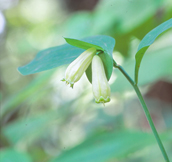
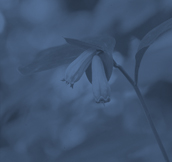 Polygonatum involucratum Liliaceae
Polygonatum involucratum Liliaceae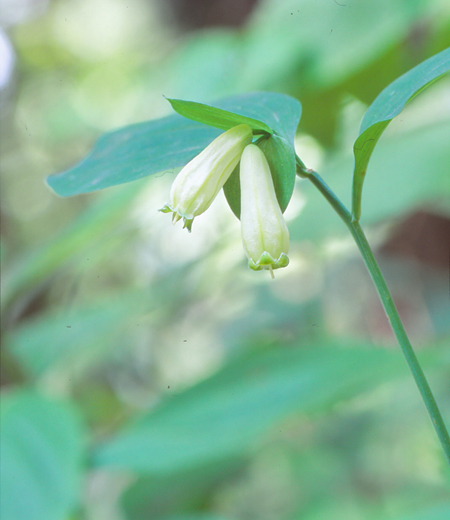 They are perennial plant that grows at deep pool of the bright forests in the mountain areas and grassy meadows. They are overall slightly grayish green, so that they are one of the undistinguished hills/fields grasses. About 1 cm flower stalk is growing from the side of the leaf, and 2 flowers are dangling to bloom like two bract leaves (Houyou: transformed leaf at the root of flower stalk) holding between. The appearance looks like the one of a prayer-gong (Waniguchi: round shaped steel drum that prayers ring) which hangs under the overhang of a Japanese roof of Shinto shrines. This is why they are named. The flower is about 2 to 2.5 cm long, tubular, and pale green with the tip rolled backwards. Bract leaves on the flowers are egg-shaped, about 2 cm long. The leaf is an elliptical shape about 5 to 10 cm long, about 2.5 to 4 cm wide with the tip a bit sharp. After flowers wither, they bear the rounded seeds about 1 cm in diameter to grow matured into black.
They are perennial plant that grows at deep pool of the bright forests in the mountain areas and grassy meadows. They are overall slightly grayish green, so that they are one of the undistinguished hills/fields grasses. About 1 cm flower stalk is growing from the side of the leaf, and 2 flowers are dangling to bloom like two bract leaves (Houyou: transformed leaf at the root of flower stalk) holding between. The appearance looks like the one of a prayer-gong (Waniguchi: round shaped steel drum that prayers ring) which hangs under the overhang of a Japanese roof of Shinto shrines. This is why they are named. The flower is about 2 to 2.5 cm long, tubular, and pale green with the tip rolled backwards. Bract leaves on the flowers are egg-shaped, about 2 cm long. The leaf is an elliptical shape about 5 to 10 cm long, about 2.5 to 4 cm wide with the tip a bit sharp. After flowers wither, they bear the rounded seeds about 1 cm in diameter to grow matured into black.
●Season Late May to about Mid June
●Height about 20 to 40 cm
●Place Ura-Takao, Oku-Takao -
Arisaema urashima Araceae
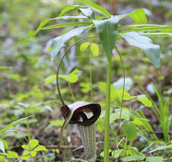
 Arisaema urashima Araceae
Arisaema urashima Araceae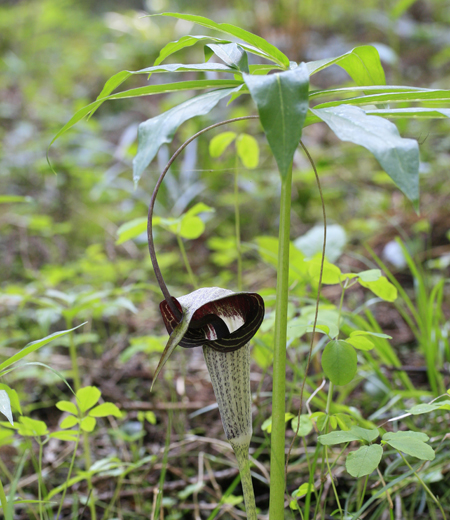 Perennial herbs found in wood shades from flatlands to low elevations. The dark-purple spathe is on peduncle grows from petiole. Is a dioecious flower, male when it is young and change to female with age. The long spadix of flowers grow from spathe is like a whip. This is like Taro Urashima (the main character of the fairy-tale in Japan, Urashima Taro) holding the fishing rod. Petioles grow upright about 50 cm like a thick stem. Have eleven to seventeen leaves grow per petioles and open like the foot of birds. Have poisonous ingredients like saponin in plants and cause mouth burn-like pain when eaten by mistake.
Perennial herbs found in wood shades from flatlands to low elevations. The dark-purple spathe is on peduncle grows from petiole. Is a dioecious flower, male when it is young and change to female with age. The long spadix of flowers grow from spathe is like a whip. This is like Taro Urashima (the main character of the fairy-tale in Japan, Urashima Taro) holding the fishing rod. Petioles grow upright about 50 cm like a thick stem. Have eleven to seventeen leaves grow per petioles and open like the foot of birds. Have poisonous ingredients like saponin in plants and cause mouth burn-like pain when eaten by mistake.
●Season Mid April to about Late May
●Height about 40 to 60 cm
●Place Ura-Takao -
Arisaema limbatum Araceae
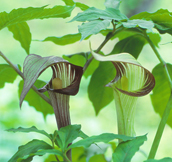
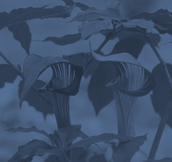 Arisaema limbatum Araceae
Arisaema limbatum Araceae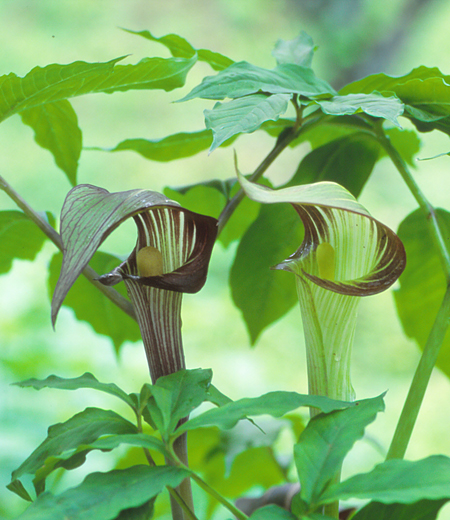 Perennial herbs found on forest floor and at forest edges in low elevations. The edges of spathe extend outward resembling earlobe, hence the Japanese name Mimigata-tennnansho literally meaning ear-shaped plants in arisaema genus. Arisaema in Chinese is tennansho, thus people started to call the same in Japan. Arisaema urashima and arisaema serratum is also in the same genus of arisaema. The dark purple-brown spathe starts to grow before leaves starts to grow open. Is a dioecious flower, changes from male to female. Petioles are short during blooming season but grow longer after flowering. Leaves are seven to eleven but some are only two. The shape of leaves is oval with irregularly placed toothed margins. Have poisonous ingredients and cause mouth burn-like pain when eaten by mistake.
Perennial herbs found on forest floor and at forest edges in low elevations. The edges of spathe extend outward resembling earlobe, hence the Japanese name Mimigata-tennnansho literally meaning ear-shaped plants in arisaema genus. Arisaema in Chinese is tennansho, thus people started to call the same in Japan. Arisaema urashima and arisaema serratum is also in the same genus of arisaema. The dark purple-brown spathe starts to grow before leaves starts to grow open. Is a dioecious flower, changes from male to female. Petioles are short during blooming season but grow longer after flowering. Leaves are seven to eleven but some are only two. The shape of leaves is oval with irregularly placed toothed margins. Have poisonous ingredients and cause mouth burn-like pain when eaten by mistake.
●Season Early April to about Late April
●Height about 30 to 70 cm
●Place Trail 1 to 6, Mt. Inari, Jyataki, Iroha, Ura-Takao, Oku-Takao,Minami-Takao, Kita-Takao -
Arisaema serratum Araceae
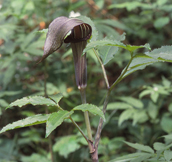
 Arisaema serratum Araceae
Arisaema serratum Araceae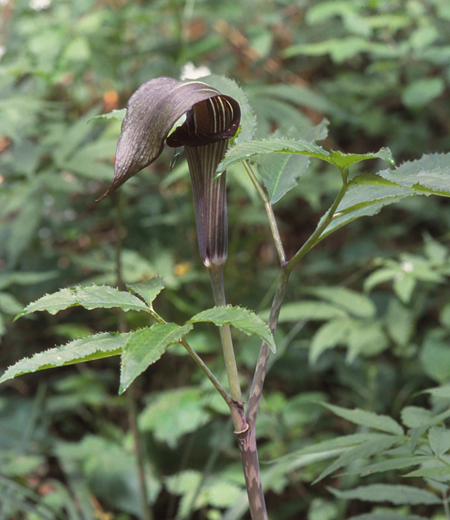 Perennial herbs found in wet wood shades and grasslands from flatlands to mountains. Flower is inside of spathe that is the different form of bracts look like large tubular petals. The purple color with irregular patterns on spathe remind people of pit viper rising its head, hence the Japanese name Murasaki-mamushi-gusa literally meaning purple pit viper plants. Leaves are wavy edged and seven to fifteen grow from one petiole. The tip of spathe is about 7 to 12 cm long and curled to cover a tubular-shaped spathe. Plants with green spathe are called Kanto-mamushigusa (Arisaema serratum).
Perennial herbs found in wet wood shades and grasslands from flatlands to mountains. Flower is inside of spathe that is the different form of bracts look like large tubular petals. The purple color with irregular patterns on spathe remind people of pit viper rising its head, hence the Japanese name Murasaki-mamushi-gusa literally meaning purple pit viper plants. Leaves are wavy edged and seven to fifteen grow from one petiole. The tip of spathe is about 7 to 12 cm long and curled to cover a tubular-shaped spathe. Plants with green spathe are called Kanto-mamushigusa (Arisaema serratum).
●Season Early May to about Late May
●Height about 30 cm to 1m
●Place Kita-Takao -
Carex morrowii Cyperaceae
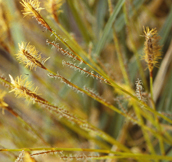
 Carex morrowii Cyperaceae
Carex morrowii Cyperaceae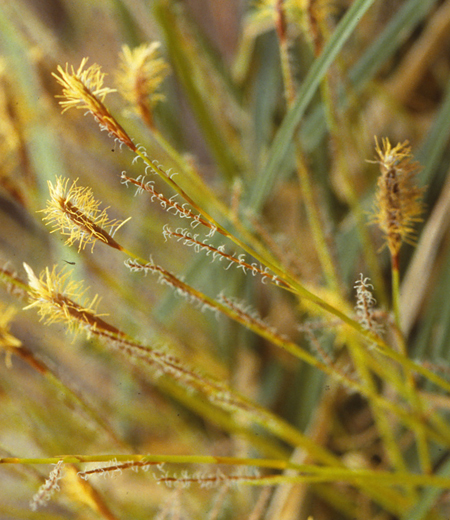 Perennial evergreen herbs (grow for several years from their same root system) found on rocks and streamside in forests in mountains. The Japanese name Kansuge literally meaning plants in cold weather was named because it has dark green leaves even in winter. Sometimes grow in clumps. Radical leaves (leaves grow from the base of a stem) are 30 to 40 cm long and 1 cm width, shiny but rough texture and with sharply serrated margins. In spring, many flower stems grow among these leaves and bloom 4 cm long and dark brown male flowers on upper stem. Female flowers bloom on the bottom, stick-shaped and 2 to 3 cm long. Male flowers grow anther (organ to produce and store pollen) to release pollen.
Perennial evergreen herbs (grow for several years from their same root system) found on rocks and streamside in forests in mountains. The Japanese name Kansuge literally meaning plants in cold weather was named because it has dark green leaves even in winter. Sometimes grow in clumps. Radical leaves (leaves grow from the base of a stem) are 30 to 40 cm long and 1 cm width, shiny but rough texture and with sharply serrated margins. In spring, many flower stems grow among these leaves and bloom 4 cm long and dark brown male flowers on upper stem. Female flowers bloom on the bottom, stick-shaped and 2 to 3 cm long. Male flowers grow anther (organ to produce and store pollen) to release pollen.
●Season Early April to Early May
●Height about 20 to 40 cm
●Place Trail 1, Trail 3 to 6, Jyataki, Ura-Takao -
Solidago virga-aurea var. asiatica (Golden Rod) Compositae
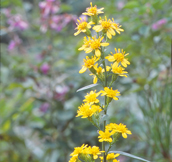
 Solidago virga-aurea var. asiatica (Golden Rod) Compositae
Solidago virga-aurea var. asiatica (Golden Rod) Compositae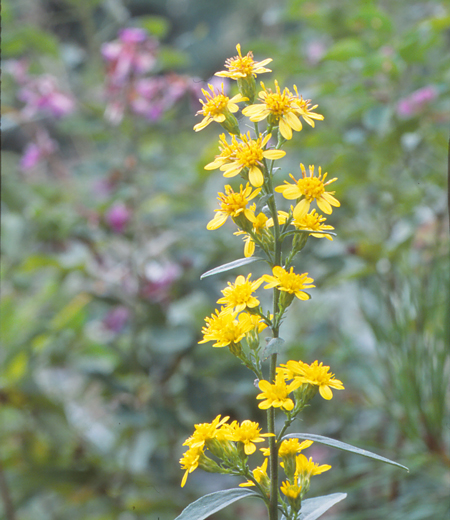 Perennial herbs found in sunny forest edge and on roadside. Yellow flowers are appealing in mountainous grassland from late summer to autumn. Japanese name Akino-Kironso literally meaning autumn phedimus aizoon var. floribundus was named because flowers resemble the beautiful yellow flowers of phedimus aizoon var. floribundus in crassulaceae family. It is also called Awadachi-so literally meaning bubble plant because they bloom like forming bubbles. Flowers are flower heads, a special type of inflorescence, in which several flowers are grouped together to form a flower-like structure and about 1.2 to 1.4 cm in diameter. Have four to six rayed flowers surrounding tubular flower in the center. Leaves are about 4 to 9 cm with toothed margins. Leaves at the base of stems are egg-shaped and become elongated oval-shaped at upper stems. After flowering, bears cylindrical seeds with about 4 mm long hair and flown by the wind.
Perennial herbs found in sunny forest edge and on roadside. Yellow flowers are appealing in mountainous grassland from late summer to autumn. Japanese name Akino-Kironso literally meaning autumn phedimus aizoon var. floribundus was named because flowers resemble the beautiful yellow flowers of phedimus aizoon var. floribundus in crassulaceae family. It is also called Awadachi-so literally meaning bubble plant because they bloom like forming bubbles. Flowers are flower heads, a special type of inflorescence, in which several flowers are grouped together to form a flower-like structure and about 1.2 to 1.4 cm in diameter. Have four to six rayed flowers surrounding tubular flower in the center. Leaves are about 4 to 9 cm with toothed margins. Leaves at the base of stems are egg-shaped and become elongated oval-shaped at upper stems. After flowering, bears cylindrical seeds with about 4 mm long hair and flown by the wind.
●Season Late September to about Early November
●Height about 30 to 80 cm
●Place Trail 1, Trail 5, Mt. Inari, Ura-Takao, Oku-Takao, Minami-Takao -
Carpesium macrocephalum Compositae
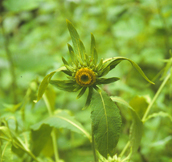
 Carpesium macrocephalum Compositae
Carpesium macrocephalum Compositae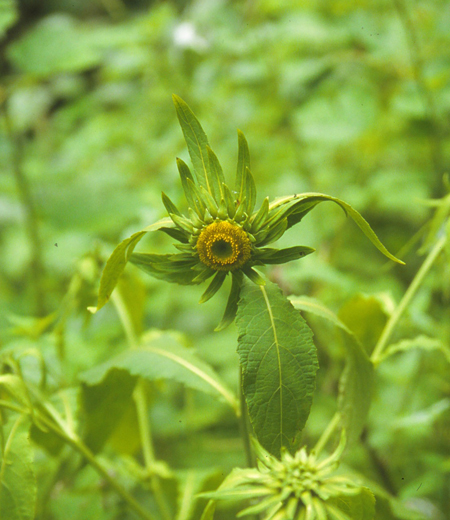 Perennial herbs found in wet shady mountain and streamside. Blooms the largest flower in carpesium divaricatum attribute. Flowers are about 2.5 to 3.5 cm in diameter and flower heads with a plenty of small flowers. Involucral segment radiate surrounding flowers and looks like a small sunflowers. Stems have many branches with curly hair. Flower stalks right beneath flower heads are thick. Leaves at the base are about 30 to 40 cm long, oval-shaped with irregularly toothed margins. Have a pointed tip, soft and thin texture. Leaves at the middle are oval-shaped and it becomes smaller as they grow tall. After flowering, bear about 6 mm long cylinder-shaped seeds with pointed tip and have mucilage.
Perennial herbs found in wet shady mountain and streamside. Blooms the largest flower in carpesium divaricatum attribute. Flowers are about 2.5 to 3.5 cm in diameter and flower heads with a plenty of small flowers. Involucral segment radiate surrounding flowers and looks like a small sunflowers. Stems have many branches with curly hair. Flower stalks right beneath flower heads are thick. Leaves at the base are about 30 to 40 cm long, oval-shaped with irregularly toothed margins. Have a pointed tip, soft and thin texture. Leaves at the middle are oval-shaped and it becomes smaller as they grow tall. After flowering, bear about 6 mm long cylinder-shaped seeds with pointed tip and have mucilage.
●Season Mid-August to about Mid-October
●Height about 60 cm to 1 m
●Place Kita-Takao -
Carpesium divaricatum Compositae
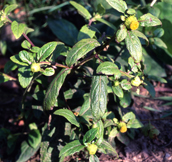
 Carpesium divaricatum Compositae
Carpesium divaricatum Compositae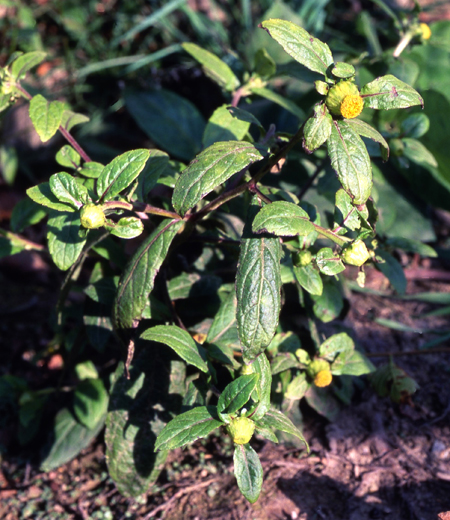 Perennial herbs found in forest edge or on roadside. Bloom single yellow flower facing sideways on tips of branched stems. Japanese name Gankubi-so literally meaning bowls of tabacco pipe plant was named because its appearance resembles the bowl of tabacco pipes. Flowers are flower heads and about 6 to 8 cm in diameter. Bloom cylindrical flowers without ray flowers so they do not look appealing. Two to four bracts below flowers surround stems. Leaves are about 7 to 20 cm long, oval-shaped with toothed margins, alternate and hairy on both sides. Radical leaves die during blooming seasons. After flowering, bear a plenty of about 3.5 mm long seeds.
Perennial herbs found in forest edge or on roadside. Bloom single yellow flower facing sideways on tips of branched stems. Japanese name Gankubi-so literally meaning bowls of tabacco pipe plant was named because its appearance resembles the bowl of tabacco pipes. Flowers are flower heads and about 6 to 8 cm in diameter. Bloom cylindrical flowers without ray flowers so they do not look appealing. Two to four bracts below flowers surround stems. Leaves are about 7 to 20 cm long, oval-shaped with toothed margins, alternate and hairy on both sides. Radical leaves die during blooming seasons. After flowering, bear a plenty of about 3.5 mm long seeds.
●Season Mid-August to about Mid-October
●Height about 25 cm to 1 m
●Place Trail 1 to 6, Mt. Inari, Jyataki, Ura-Takao -
Senecio nikoensis Compositae
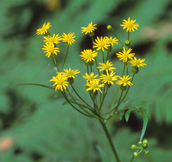
 Senecio nikoensis Compositae
Senecio nikoensis Compositae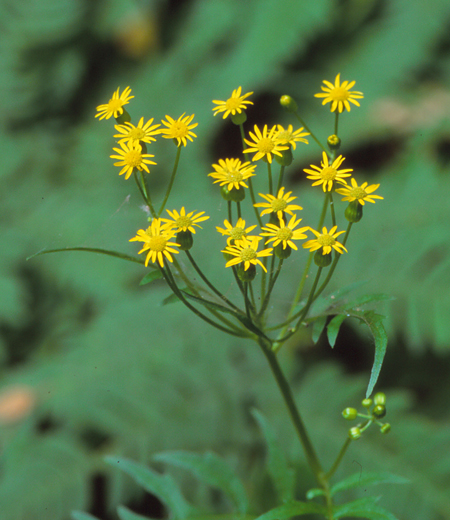 Perennial herbs found in wet forest, often along streamside as Japanese name Sawa-giku literally meaning streamside chrysanthemum states. Tall with bright yellow flowers so they are appealing. Flowers are 1 cm in diameter and boom a plenty of them at the end of branches. Seven to thirteen ray flowers and have many tubular flowers. Leaves are alternate, about 3 to 9 cm long and distinctly lobed and feather-like shaped. Radical leaves die during blooming season. After flowering, bears about 1.5 mm long seeds with hairs and flown by the wind. It is also called as Boro-gikku literally meaning waste chrysanthemum because hair resembles cotton waste.
Perennial herbs found in wet forest, often along streamside as Japanese name Sawa-giku literally meaning streamside chrysanthemum states. Tall with bright yellow flowers so they are appealing. Flowers are 1 cm in diameter and boom a plenty of them at the end of branches. Seven to thirteen ray flowers and have many tubular flowers. Leaves are alternate, about 3 to 9 cm long and distinctly lobed and feather-like shaped. Radical leaves die during blooming season. After flowering, bears about 1.5 mm long seeds with hairs and flown by the wind. It is also called as Boro-gikku literally meaning waste chrysanthemum because hair resembles cotton waste.
●Season Early June to about Mid-July
●Height about 50 cm to 1 m
●Place Trail 3, Trail 6, Ura-Takao, Oku-Takao -
Cirsium oligophyllum Compositae
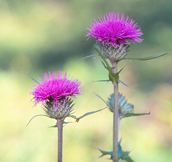
 Cirsium oligophyllum Compositae
Cirsium oligophyllum Compositae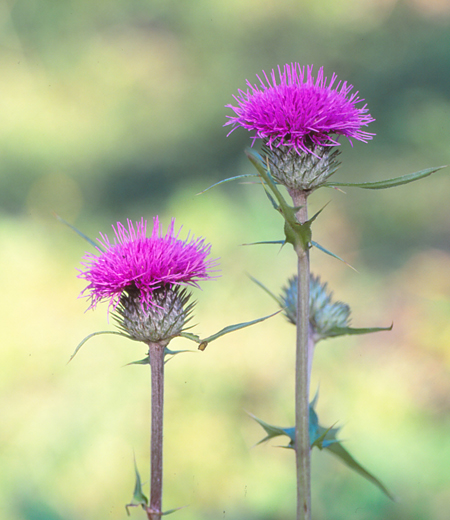 Perennial herbs found on sunny hills, grassland and forest edge. Flowers are about 4 cm in diameter flower heads, facing up and red-purple. Bloom two to three flowers at the tips of long upright stems. Involucre surrounding flowers are like flower buds, tubular, dropping bell-shaped and about 1.5 to 2 cm long. Resemble cirsium japonicum bloom in spring, but their involucre is not mucilage and recurved like aculeus. Radical leaves remain during blooming season, sparsely grow, about 30 cm long and distinctly lobed. Leave veins are red-purple. After flowering, bear hairy seeds.
Perennial herbs found on sunny hills, grassland and forest edge. Flowers are about 4 cm in diameter flower heads, facing up and red-purple. Bloom two to three flowers at the tips of long upright stems. Involucre surrounding flowers are like flower buds, tubular, dropping bell-shaped and about 1.5 to 2 cm long. Resemble cirsium japonicum bloom in spring, but their involucre is not mucilage and recurved like aculeus. Radical leaves remain during blooming season, sparsely grow, about 30 cm long and distinctly lobed. Leave veins are red-purple. After flowering, bear hairy seeds.
●Season August to about Mid-October
●Height about 50 cm to 1 m
●Place Trail 2, Ura-Takao, Oku-Takao -
Adenocaulon himalaicum Compositae
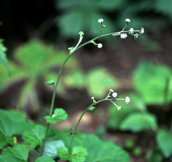
 Adenocaulon himalaicum Compositae
Adenocaulon himalaicum Compositae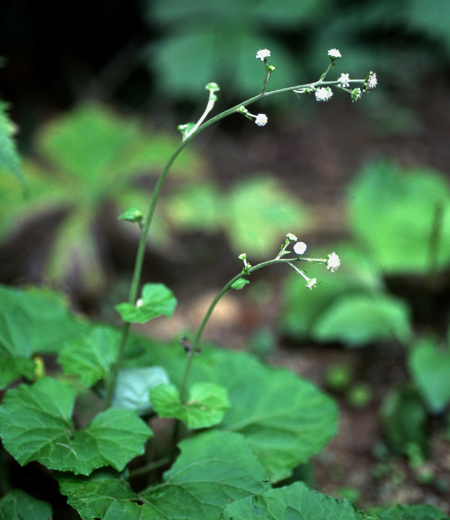 Perennial herbs found on wet streamside, roadside and in forest edge. Japanese name Nobuki literally meaning wild Japanese butterbur was named because leaves resemble Japanese butterbur. Leaves tip are more pointed than Japanese butterbur with shallow wings on its leave stalks. Leaves are about 10 to 20 cm triangular kidney-shaped have white hairs on reverse side. Upright stems branches out at tips and bloom many flowers. Flowers are white, about about 7 to 11 male flowers surrounding female flowers in the center. Fruits after flowering are green bar-shaped and about about 6 to 7 mm long. Seeds have dark purplish hair with mucilage and are carried by sticking themselves to animals or clothes of human being. Sprouts are edible.
Perennial herbs found on wet streamside, roadside and in forest edge. Japanese name Nobuki literally meaning wild Japanese butterbur was named because leaves resemble Japanese butterbur. Leaves tip are more pointed than Japanese butterbur with shallow wings on its leave stalks. Leaves are about 10 to 20 cm triangular kidney-shaped have white hairs on reverse side. Upright stems branches out at tips and bloom many flowers. Flowers are white, about about 7 to 11 male flowers surrounding female flowers in the center. Fruits after flowering are green bar-shaped and about about 6 to 7 mm long. Seeds have dark purplish hair with mucilage and are carried by sticking themselves to animals or clothes of human being. Sprouts are edible.
●Season Late August to about Late October
●Height about 50 to 80 cm
●Place Trail 4, Trail 6, Ura-Takao -
Syneilesis palmate (Shredded Umbrella Plant) Compositae
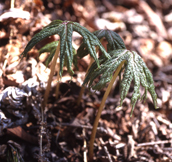
 Syneilesis palmate (Shredded Umbrella Plant) Compositae
Syneilesis palmate (Shredded Umbrella Plant) Compositae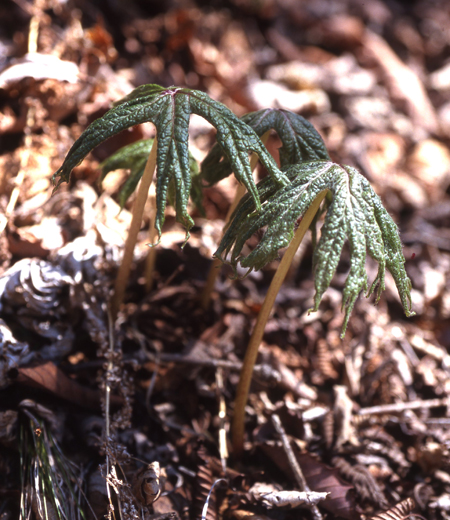 Perennial herbs found on hills and in mountain forests. Japanese name Yaburegasa literally meaning shredded umbrella plants was named because its young leaves sprouted from the ground around mid-April resemble half-open shredded umbrella. At first, an upright flower stalk grows from one radical leaf and blooms about 1 cm in diameter flower. Flowers are flower heads and white or pale red. Bloom seven to thirteen five-lobed tubular flowers and protruding stamens are appealing. Leaves are round-shaped, about 35 to 50 cm in diameter and distinctly lobed like the palm with long stalks. Young leaves have cotton hair and it disappear as it grows. Young leaves are edible, boiled leaves can be marinated, vinegared or used for soup, and fresh leaves for deep fried tempura.
Perennial herbs found on hills and in mountain forests. Japanese name Yaburegasa literally meaning shredded umbrella plants was named because its young leaves sprouted from the ground around mid-April resemble half-open shredded umbrella. At first, an upright flower stalk grows from one radical leaf and blooms about 1 cm in diameter flower. Flowers are flower heads and white or pale red. Bloom seven to thirteen five-lobed tubular flowers and protruding stamens are appealing. Leaves are round-shaped, about 35 to 50 cm in diameter and distinctly lobed like the palm with long stalks. Young leaves have cotton hair and it disappear as it grows. Young leaves are edible, boiled leaves can be marinated, vinegared or used for soup, and fresh leaves for deep fried tempura.
●Season Late June to about Mid-October
●Height about 50 cm to 1 m
●Place Trail 1, Trail 3 to 5, Ura-Takao, Kita-Takao -
Kalimeris pinnatifida Compositae
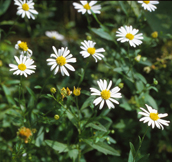
 Kalimeris pinnatifida Compositae
Kalimeris pinnatifida Compositae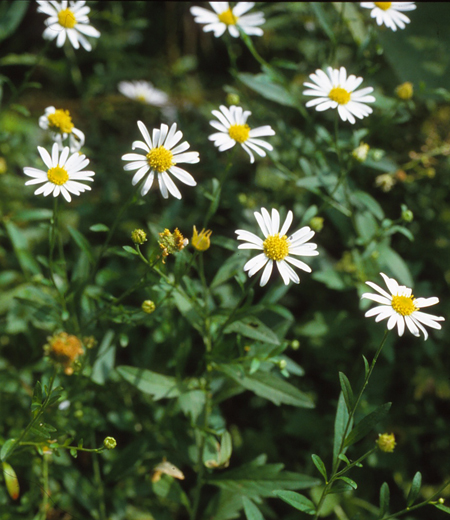 Perennial herbs found in sunny grassland or on roadside. Tends to cluster by extending rhizomes. Is a kind of wild chrysanthemum and Japanese name Yuga-giku literally meaning yuzu scented chrysanthemum was named because leaves scented slightly like yuzu, however it does not smell like that at all so its actual origin is yet unknown. Flowers are about 2.5 cm in diameter, flower heads, white or pale purple ray flowers surrounding yellow tubular flower. Upper stems branch out and bloom some flowers at its tip. Leaves are about 7 to 8 cm long, egg-like elongated oval-shaped and pinnately lobed. Resemble kalimeris pseudoyomena in the same attribute but kalimelis pinnatifida has feather-lobed leaves and grows multiple branches.
Perennial herbs found in sunny grassland or on roadside. Tends to cluster by extending rhizomes. Is a kind of wild chrysanthemum and Japanese name Yuga-giku literally meaning yuzu scented chrysanthemum was named because leaves scented slightly like yuzu, however it does not smell like that at all so its actual origin is yet unknown. Flowers are about 2.5 cm in diameter, flower heads, white or pale purple ray flowers surrounding yellow tubular flower. Upper stems branch out and bloom some flowers at its tip. Leaves are about 7 to 8 cm long, egg-like elongated oval-shaped and pinnately lobed. Resemble kalimeris pseudoyomena in the same attribute but kalimelis pinnatifida has feather-lobed leaves and grows multiple branches.
●Season July to about October
●Height about 40 cm to 1.5 m
●Place Ura-Takao, Oku-Takao -
Adenophora divaricata Campanulaceae
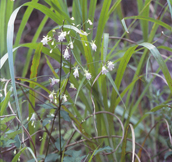
 Adenophora divaricata Campanulaceae
Adenophora divaricata Campanulaceae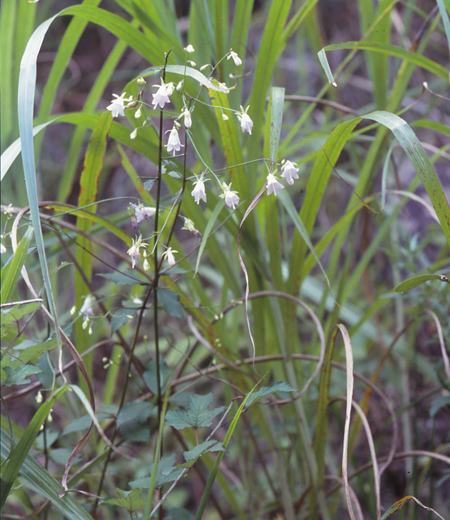 Perennial herbs found in dry forest edge and grassland. Japanese name Fukushima-shajin literally meaning Fukushima prefecture herbal plant was named because it was first found in Fukushima prefecture. Flowers are tubular dropping bell-shaped and about about 2 cm long. Flower stalks randomly grow from tips of stems and bloom light purple flowers drooping down from the stalks. Five lobed flowers open like a bell. Flowers resemble adenophora triphylla in the same family. The difference is the calyx, thin needle-like shape for adenophora triphylla, and this flower’s ones are rather wide. Leaves are long oval-shaped, about 5 to 8 cm long and in whorls of three or four. Leaves are large at the base and become smaller as they grow tall. Both sides of the leaves have soft hair and longer on the reverse side. After flowering, bear fruits when ripe.
Perennial herbs found in dry forest edge and grassland. Japanese name Fukushima-shajin literally meaning Fukushima prefecture herbal plant was named because it was first found in Fukushima prefecture. Flowers are tubular dropping bell-shaped and about about 2 cm long. Flower stalks randomly grow from tips of stems and bloom light purple flowers drooping down from the stalks. Five lobed flowers open like a bell. Flowers resemble adenophora triphylla in the same family. The difference is the calyx, thin needle-like shape for adenophora triphylla, and this flower’s ones are rather wide. Leaves are long oval-shaped, about 5 to 8 cm long and in whorls of three or four. Leaves are large at the base and become smaller as they grow tall. Both sides of the leaves have soft hair and longer on the reverse side. After flowering, bear fruits when ripe.
●Season Mid-August to about Early September
●Height about 60 cm to 1 m
●Place Ura-Takao -
Campanula punctata ( Spotted Bellflower) Campanulaceae
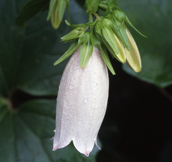
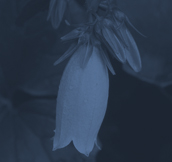 Campanula punctata ( Spotted Bellflower) Campanulaceae
Campanula punctata ( Spotted Bellflower) Campanulaceae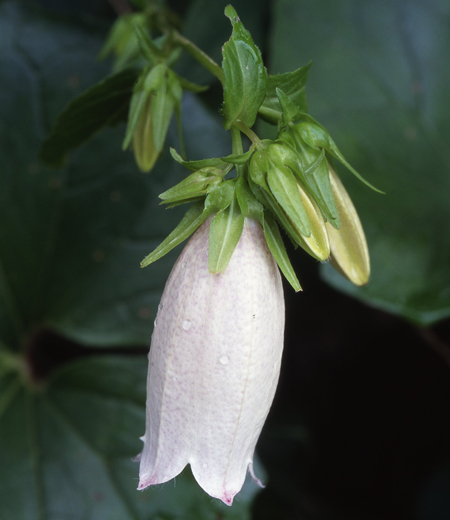 Perennial herbs found in dry mountainous grassland or on roadside. Have hair on its full body and grow with a prostrate stem from each node. Japanese name Hotaru-Bukuro literally meaning firefly’s bag because flowers are paper lantern-shaped and children played fireflies inside of the flowers. Flowers are about about 4 to 5 cm long, tubular and dropping bell-shaped, and white, purple and light red. Five-lobed petals are with recurved appendages between calyx. Similar flowers, campanula punctata lam. var. hondoensis (kitam.) ohwi are without these appendages. Leaves are about 5 to 7 cm long, oval-shaped with pointed tip and toothed margins. Radical leaves are heart-shaped and die when blooming season start.
Perennial herbs found in dry mountainous grassland or on roadside. Have hair on its full body and grow with a prostrate stem from each node. Japanese name Hotaru-Bukuro literally meaning firefly’s bag because flowers are paper lantern-shaped and children played fireflies inside of the flowers. Flowers are about about 4 to 5 cm long, tubular and dropping bell-shaped, and white, purple and light red. Five-lobed petals are with recurved appendages between calyx. Similar flowers, campanula punctata lam. var. hondoensis (kitam.) ohwi are without these appendages. Leaves are about 5 to 7 cm long, oval-shaped with pointed tip and toothed margins. Radical leaves are heart-shaped and die when blooming season start.
●Season Mid-June to about Late July
●Height about 30 to 80 cm
●Place Trail 1, Trail 5, Mt. Inari, Jyataki, Ura-Takao, Oku-Takao,
Minami-Takao -
Gynostemma pentaphyllum (Five-leaf Ginseng) Cucurbitaceae
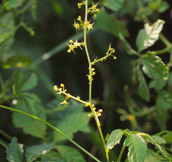
 Gynostemma pentaphyllum (Five-leaf Ginseng) Cucurbitaceae
Gynostemma pentaphyllum (Five-leaf Ginseng) Cucurbitaceae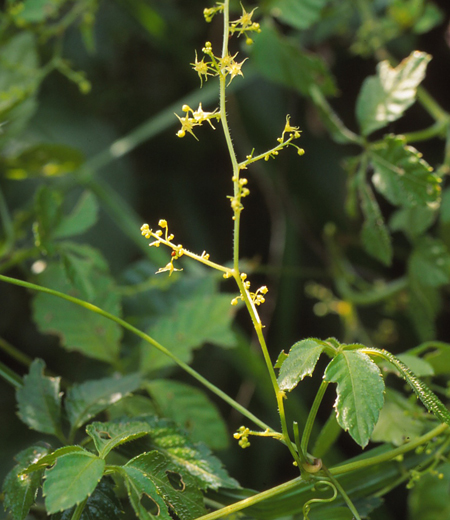 Perennial vines found in mountainous forest edge. Have stems that trail around ground and then twine adjacent plants. It is named after Amacha (Sweet tea, a kind of hydrangea) served at flower festival to celebrate the birthday of Buddha because leaves have slightly sweet taste. Leaves and stems are brewed as gynostemma pentaphyllum tea. Flowers are star-shaped, about 5 mm in diameter, light green, dioecious and bloom randomly from the axils of leaves. Five leaves are like bird feet and alternate. In autumn, bear fully moistened fruits and about 7 mm in diameter. Fruits have a ring-like line and greenish black when ripe. Vines are edible, stir-fry or deep fry.
Perennial vines found in mountainous forest edge. Have stems that trail around ground and then twine adjacent plants. It is named after Amacha (Sweet tea, a kind of hydrangea) served at flower festival to celebrate the birthday of Buddha because leaves have slightly sweet taste. Leaves and stems are brewed as gynostemma pentaphyllum tea. Flowers are star-shaped, about 5 mm in diameter, light green, dioecious and bloom randomly from the axils of leaves. Five leaves are like bird feet and alternate. In autumn, bear fully moistened fruits and about 7 mm in diameter. Fruits have a ring-like line and greenish black when ripe. Vines are edible, stir-fry or deep fry.
●Season August to about September
●Height Vine
●Place Ura-Takao -
Patrinia villosa Valerianaceae
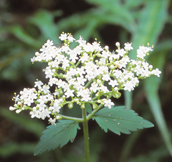
 Patrinia villosa Valerianaceae
Patrinia villosa Valerianaceae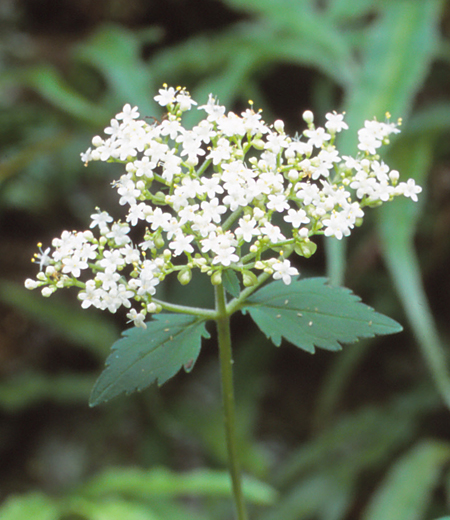 Perennial herbs found on sunny hills and fields. Are runner plants and produce numerous runners to reproduce new plants. Japanese name, Otokoeshi literally meaning masculine flower is named to differentiate them from Ominaeshi (patrinia scabiosifolia) literally meaning feminine flower with yellow flowers because Otokoeshi’s stems and leaves are large and looks strong and tough masculine image even though its flowers are white and simple. Flowers are about 4 mm in diameter and bloom on the tip of branches. Leaves are oval-shape and about 3 to 15 cm long and stem leaves are pinnately parted. Stems at the base have rough white hair. After flowering, bears oval and about 3 mm long fruits. Fruits has round-shaped wings and can be flown by the wind when ripe. Roots are used as Chinese medicine for its anti-inflammatory effects.
Perennial herbs found on sunny hills and fields. Are runner plants and produce numerous runners to reproduce new plants. Japanese name, Otokoeshi literally meaning masculine flower is named to differentiate them from Ominaeshi (patrinia scabiosifolia) literally meaning feminine flower with yellow flowers because Otokoeshi’s stems and leaves are large and looks strong and tough masculine image even though its flowers are white and simple. Flowers are about 4 mm in diameter and bloom on the tip of branches. Leaves are oval-shape and about 3 to 15 cm long and stem leaves are pinnately parted. Stems at the base have rough white hair. After flowering, bears oval and about 3 mm long fruits. Fruits has round-shaped wings and can be flown by the wind when ripe. Roots are used as Chinese medicine for its anti-inflammatory effects.
●Season August to about October
●Height about 60 cm to 1 m
●Place Trail 3, Minami-Takao -
Phryma leptostahya var. asiatica Phrymaceae
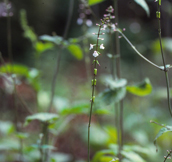
 Phryma leptostahya var. asiatica Phrymaceae
Phryma leptostahya var. asiatica Phrymaceae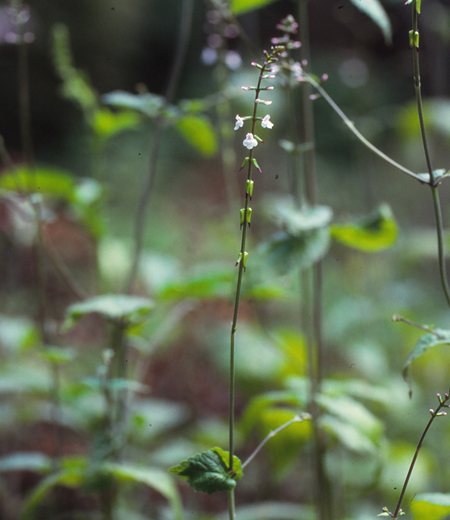 Perennial herbs (grow for several years from their same root system) found in forests and shrubs on hills and low elevations. The entire plant is poisonous and paper dipped in water roots are boiled was used to catch flies, hence the Japanese name Haedoku-so. Thin flower stems (stems for flowers without leaves) grow from tips of stem and bloom in flower spikes. Flowers are 5 to 6 mm, light reddish white. Tip of lips are open like lips and lower petals shallowly split in three. Have four stamens and two of them are large. Buds grow upright, flowers bloom facing side and fruits face downward. Leaves are 7 to 10 cm long, 4 to 7 cm width, egg-shaped to oval shaped with toothed margins (edges of leaves are like a teeth of saw) and opposite. Seeds are covered by bracts with prickles and carried by sticking itself to animals or cloths.
Perennial herbs (grow for several years from their same root system) found in forests and shrubs on hills and low elevations. The entire plant is poisonous and paper dipped in water roots are boiled was used to catch flies, hence the Japanese name Haedoku-so. Thin flower stems (stems for flowers without leaves) grow from tips of stem and bloom in flower spikes. Flowers are 5 to 6 mm, light reddish white. Tip of lips are open like lips and lower petals shallowly split in three. Have four stamens and two of them are large. Buds grow upright, flowers bloom facing side and fruits face downward. Leaves are 7 to 10 cm long, 4 to 7 cm width, egg-shaped to oval shaped with toothed margins (edges of leaves are like a teeth of saw) and opposite. Seeds are covered by bracts with prickles and carried by sticking itself to animals or cloths.
●Season Mid July to about Mid August
●Height about 30 to 70 cm
●Place Trail 1 to 6, Mt. Inari, Jyataki, Ura-Takao -
Galium kinuta Rubiaceae
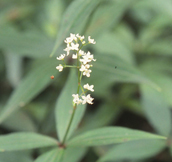
 Galium kinuta Rubiaceae
Galium kinuta Rubiaceae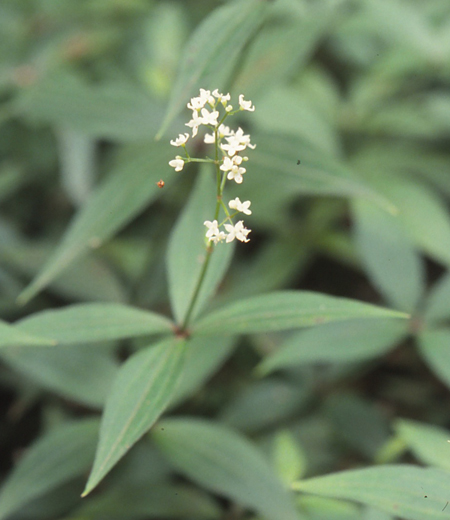 Perennials herbs found on mountain slopes and in woods. Is known for its small cute flowers bloom in summer. Japanese name “Kinuta-So” was named because round shaped nuts resemble Kinuta (a fulling block used to beat the fibers to make the cloth thicker and/or softer). Flowers are white cross-shaped and about 2 to 3 mm in diameter. Stems are square cross sectional and grow upright and have three or four flower stalks grow multiple branches from the tip. Leaves are narrowly oval-shaped with pointed tip, leathery, about 2 to 8 cm long and about 0.8 to 2.5 cm wide with three principal veins. Leaves are in whorls of four, radiating from a single stem.
Perennials herbs found on mountain slopes and in woods. Is known for its small cute flowers bloom in summer. Japanese name “Kinuta-So” was named because round shaped nuts resemble Kinuta (a fulling block used to beat the fibers to make the cloth thicker and/or softer). Flowers are white cross-shaped and about 2 to 3 mm in diameter. Stems are square cross sectional and grow upright and have three or four flower stalks grow multiple branches from the tip. Leaves are narrowly oval-shaped with pointed tip, leathery, about 2 to 8 cm long and about 0.8 to 2.5 cm wide with three principal veins. Leaves are in whorls of four, radiating from a single stem.
●Season July to about September
●Height about 30 to 50 cm
●Place Oku-Takao -
Paederia scandens var.mairei (Skunk Vine) Rubiaceae
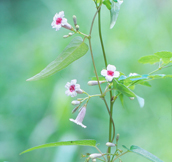
 Paederia scandens var.mairei (Skunk Vine) Rubiaceae
Paederia scandens var.mairei (Skunk Vine) Rubiaceae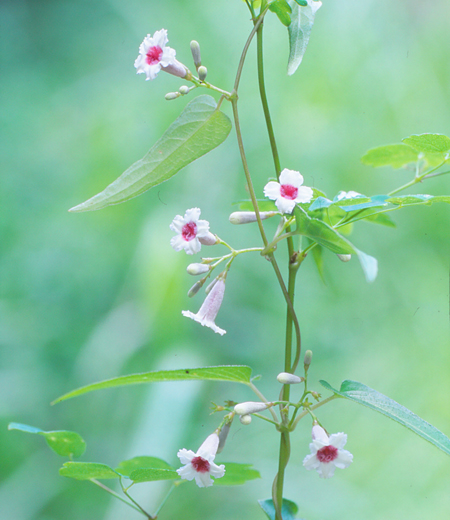 Perennial vine found in sunny woodland, grassland and on riverbank. Vein twines around adjacent plants from a woody rootstock. It was named because of their distinct odor when kneading leaves or stems, or crushing fruits. Flowers are dropping tubular, bell-shaped and 1 cm long. Flower stalks are randomly borne from the axils of leaves. Contrary to the image from its name, bloom cute white flowers with magenta center. It also has Japanese name Saotome-Kazura literally meaning straw hat that rice planting young women wear. Leaves are heart-shaped with pointed tip and stipules on leafstalks are triangle-shaped like scales. Bears shiny brownish yellow fruits after flowering with two seeds inside and have long been used as folk remedy for curing frostbite and chapped skin.
Perennial vine found in sunny woodland, grassland and on riverbank. Vein twines around adjacent plants from a woody rootstock. It was named because of their distinct odor when kneading leaves or stems, or crushing fruits. Flowers are dropping tubular, bell-shaped and 1 cm long. Flower stalks are randomly borne from the axils of leaves. Contrary to the image from its name, bloom cute white flowers with magenta center. It also has Japanese name Saotome-Kazura literally meaning straw hat that rice planting young women wear. Leaves are heart-shaped with pointed tip and stipules on leafstalks are triangle-shaped like scales. Bears shiny brownish yellow fruits after flowering with two seeds inside and have long been used as folk remedy for curing frostbite and chapped skin.
●Season August to about September
●Height Vine
●Places Trail 1, Trail 4、Ura-Takao, Oku-Takao -
Dicliptera japonica Acanthaceae
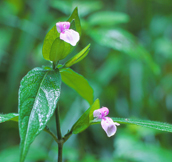
 Dicliptera japonica Acanthaceae
Dicliptera japonica Acanthaceae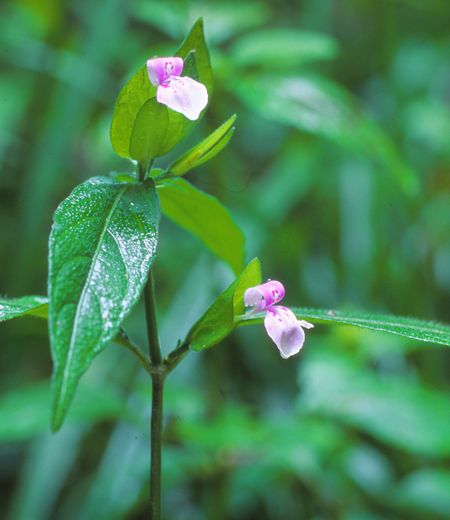 Perennial herbs found in shady streamside in mountainous land and forest edge. Two lip-shaped petals are very unique and protruding stamens and pistils look like a tongue. About 5 to 15 mm long flower stalks grow from the tip of stems or axils of leaves and bloom flowers between two bracts like placing palms together. Flowers are red-purple, about 3 cm long, upper petals are slim with curled tip and lower petals are round and big. Have deep red-purple dots in inner side of petals. Leaves are about 5 to 8 cm egg-like elongated oval-shaped and opposite. Japanese name Haguroso literally meaning leaf black plants was named after dark green colored leaves. After flowering, bear about 9 to 12 mm long fruits.
Perennial herbs found in shady streamside in mountainous land and forest edge. Two lip-shaped petals are very unique and protruding stamens and pistils look like a tongue. About 5 to 15 mm long flower stalks grow from the tip of stems or axils of leaves and bloom flowers between two bracts like placing palms together. Flowers are red-purple, about 3 cm long, upper petals are slim with curled tip and lower petals are round and big. Have deep red-purple dots in inner side of petals. Leaves are about 5 to 8 cm egg-like elongated oval-shaped and opposite. Japanese name Haguroso literally meaning leaf black plants was named after dark green colored leaves. After flowering, bear about 9 to 12 mm long fruits.
●Season Mid-August to about Early October
●Height about 20 to 40 cm
●Place Trail 1 to 4, Trail 6, Jyataki, Ura-Takao -
Conandron ramondioides Gesneriaceae
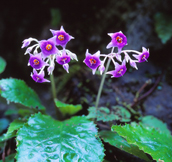
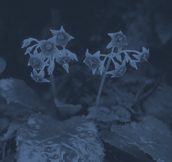 Conandron ramondioides Gesneriaceae
Conandron ramondioides Gesneriaceae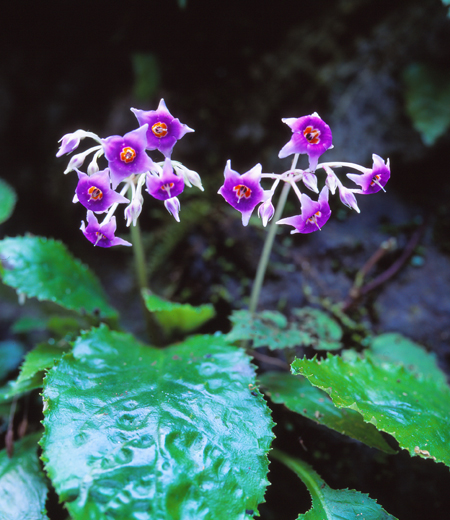 Perennials herbs found on wet streamside rocks. One or Two large leaves appear at the base of the plants and Japanese name Iwa-Tabako literally meaning rocks tabacco was named because the shape of leaves resemble tabacco leaves. Flowers are star-shaped about 1.5 to 2 cm in diameter with corolla tube. Bloom light purple flowers and white center with orange mottling. Flower stalks grow between leaves and bloom two or three flowers. Leaves are about 10 to 30 cm egg-like oval-shaped with irregularly toothed margins. Soft and crape like wrinkles on surface of leaves. In winter, leaves wrap fruits to protect them from cold weather. Young leaves from April to about June are edible, boiled or deep fried or even fresh and have slight sticky and bitter taste.
Perennials herbs found on wet streamside rocks. One or Two large leaves appear at the base of the plants and Japanese name Iwa-Tabako literally meaning rocks tabacco was named because the shape of leaves resemble tabacco leaves. Flowers are star-shaped about 1.5 to 2 cm in diameter with corolla tube. Bloom light purple flowers and white center with orange mottling. Flower stalks grow between leaves and bloom two or three flowers. Leaves are about 10 to 30 cm egg-like oval-shaped with irregularly toothed margins. Soft and crape like wrinkles on surface of leaves. In winter, leaves wrap fruits to protect them from cold weather. Young leaves from April to about June are edible, boiled or deep fried or even fresh and have slight sticky and bitter taste.
●Season Late July to about Mid-August
●Height about 10 to 30 cm
●Places Trail 6, Jyataki -
Phacellanthus tubiflorus Orobanchaceae
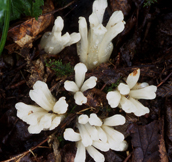
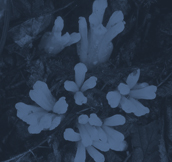 Phacellanthus tubiflorus Orobanchaceae
Phacellanthus tubiflorus Orobanchaceae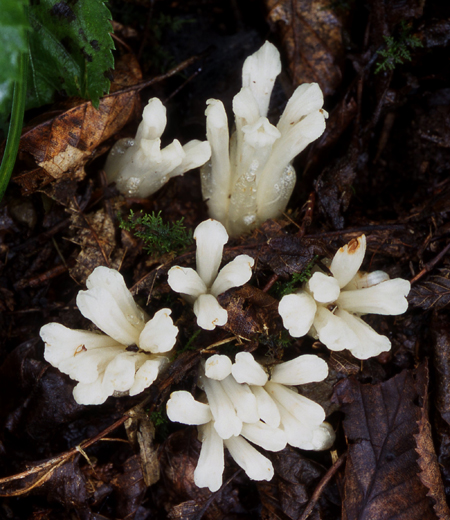 Perennial herbs (grow for several years from their same root system) found around roots of trees. Does not have chlorophyl and leaves because they receive nutrients and grow. Found in wet area including tree shades near some trees in fagaceae family and hydrangea. In Mt. Takao, often found around the root of hydrangea involucrate. It was first found in Mt. Kiyosumi in Chiba prefecture, hence the Japanese name Kiyosumi-utsubo literally meaning plants in orobanchaceae family found in Kiyosumi prefecture. Some stems grow together from the ground and have five to 10 fleshy flowers in clusters. Buds are covered with scale-like leaves, creating spherical shape. Flowers are tubular, 2 to 3 cm, white at first and turns to yellow. Tips are lobed in tow and four stamens are from the center of flowers. After flowering, bear 0..5 to 1..5 cm in diameter white spherical fruits.
Perennial herbs (grow for several years from their same root system) found around roots of trees. Does not have chlorophyl and leaves because they receive nutrients and grow. Found in wet area including tree shades near some trees in fagaceae family and hydrangea. In Mt. Takao, often found around the root of hydrangea involucrate. It was first found in Mt. Kiyosumi in Chiba prefecture, hence the Japanese name Kiyosumi-utsubo literally meaning plants in orobanchaceae family found in Kiyosumi prefecture. Some stems grow together from the ground and have five to 10 fleshy flowers in clusters. Buds are covered with scale-like leaves, creating spherical shape. Flowers are tubular, 2 to 3 cm, white at first and turns to yellow. Tips are lobed in tow and four stamens are from the center of flowers. After flowering, bear 0..5 to 1..5 cm in diameter white spherical fruits.
●Season Mid June to about Mid July
●Height about 5 to 10 cm
●Place Trail 3, Trail 6 -
Mimulus nepalensis var.japonica Scrophulariaceae
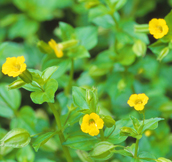
 Mimulus nepalensis var.japonica Scrophulariaceae
Mimulus nepalensis var.japonica Scrophulariaceae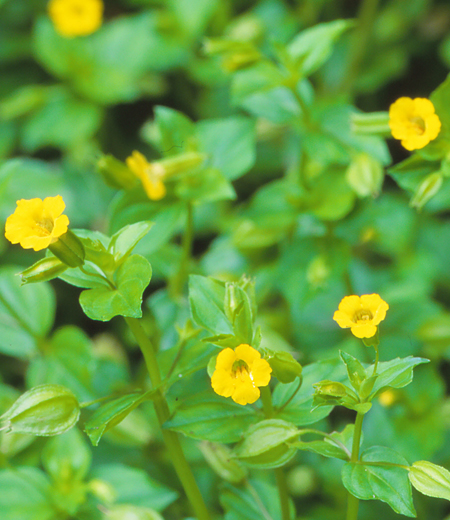 Perennial herbs found along forest roads where spring water well. Stems are soft and grow multiple branches. Japanese name Mizo-houzuki literally meaning vallecula ground cherries was named because they grow on wet vallecula and its fruits resemble ground cherries in solanaceae family. Flowers are about 1 to 2 cm in diameter and yellow. Bloom trumpet-shaped tubular flowers from the axils of leaves at tips of stems. Five lobed petals with round edge, red-brownish dotted in the center and two hair-like protrusions. Calyxes are also tubular and lobed in five. Leaves are about 2 to 4 cm long and egg-like oval-shaped with roughly toothed margins. After flowering, bear elongated oval-shaped fruits covered by about 5 protruded calyxes.
Perennial herbs found along forest roads where spring water well. Stems are soft and grow multiple branches. Japanese name Mizo-houzuki literally meaning vallecula ground cherries was named because they grow on wet vallecula and its fruits resemble ground cherries in solanaceae family. Flowers are about 1 to 2 cm in diameter and yellow. Bloom trumpet-shaped tubular flowers from the axils of leaves at tips of stems. Five lobed petals with round edge, red-brownish dotted in the center and two hair-like protrusions. Calyxes are also tubular and lobed in five. Leaves are about 2 to 4 cm long and egg-like oval-shaped with roughly toothed margins. After flowering, bear elongated oval-shaped fruits covered by about 5 protruded calyxes.
●Season Early June to about Late July
●Height about 10 to 30 cm
●Place Trail 3, Trail 6, Jyataki, Ura-Takao -
Clinopodium micranthum Labiatae
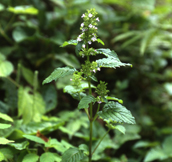
 Clinopodium micranthum Labiatae
Clinopodium micranthum Labiatae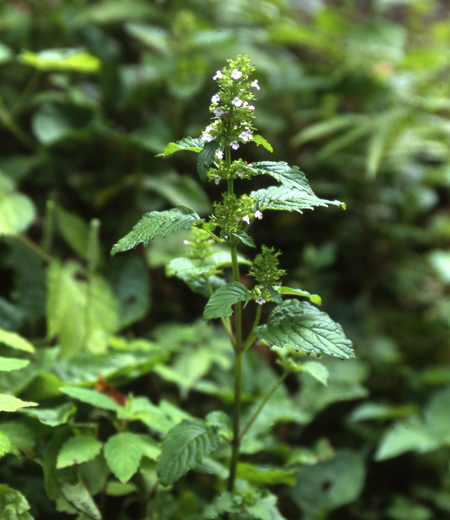 Perennial herbs (grow for several years from their same root system) found under tree shades and at forest edges in mountains. Short hair facing downward grow densely on stems. Flowers are 5 to 6 mm long, tubular shaped with lip-like tips. Bloom many light reddish white flowers create cylindrical flower spike. Calyx covering petals have long white hair. Leaves are egg-shaped to shallow egg-shaped, 2 to 3 cm, tips are pointed with toothed margins (edges of leaves are like a teeth of saw). Texture is thin and hair on both sides. Have distinct leaf glands producing nectar that attracts ants to protect the plants from pests. The Japanese name Inu-tobana was named because it resembles clinopodium gracile (Toubana in Japanese) in the same family but inu (not the same in Japanese) was added to describe it is different from clinopodium gracile.
Perennial herbs (grow for several years from their same root system) found under tree shades and at forest edges in mountains. Short hair facing downward grow densely on stems. Flowers are 5 to 6 mm long, tubular shaped with lip-like tips. Bloom many light reddish white flowers create cylindrical flower spike. Calyx covering petals have long white hair. Leaves are egg-shaped to shallow egg-shaped, 2 to 3 cm, tips are pointed with toothed margins (edges of leaves are like a teeth of saw). Texture is thin and hair on both sides. Have distinct leaf glands producing nectar that attracts ants to protect the plants from pests. The Japanese name Inu-tobana was named because it resembles clinopodium gracile (Toubana in Japanese) in the same family but inu (not the same in Japanese) was added to describe it is different from clinopodium gracile.
●Season Late July to about Mid September
●Height about 20 to 50 cm
●Place Trail 1 to 3, Trail 5 to 6, Jyataki, Ura-Takao, Kita-Takao -
Prunella vulgaris ssp. asiatica Labiatae
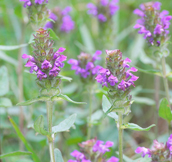
 Prunella vulgaris ssp. asiatica Labiatae
Prunella vulgaris ssp. asiatica Labiatae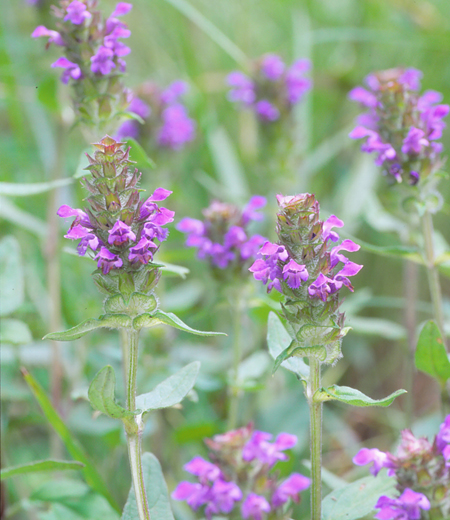 Perennial herbs (grow for several years from their same root system) found in sunny grasslands and on roadside. Have white hair on the entire body and grow by extending runners (branches grow along the ground). Have 3 to 8 cm long tubular and many flowers create cylindrical shaped flower spike and bloom blue-purple flowers. Flowers are 1..5 to 2 cm long, upper petals nodding, lower petal lobed in three and center petal with toothed margins (edges of leaves are like a teeth of saw). Calyx is pinnate in five with pointed tip. Leaves are 2 to 5 cm elongated oval-shaped. The Japanese name Utsubo-gusa literally meaning arrow case plant was named because the flower of shape resembles elongated arrow case called utsubo in Japanese. It is also called as Kako-so literally meaning plant die off in summer because brown dead flower remains upright. Dried flower is roasted and used to curative medicine for diuretic effects.
Perennial herbs (grow for several years from their same root system) found in sunny grasslands and on roadside. Have white hair on the entire body and grow by extending runners (branches grow along the ground). Have 3 to 8 cm long tubular and many flowers create cylindrical shaped flower spike and bloom blue-purple flowers. Flowers are 1..5 to 2 cm long, upper petals nodding, lower petal lobed in three and center petal with toothed margins (edges of leaves are like a teeth of saw). Calyx is pinnate in five with pointed tip. Leaves are 2 to 5 cm elongated oval-shaped. The Japanese name Utsubo-gusa literally meaning arrow case plant was named because the flower of shape resembles elongated arrow case called utsubo in Japanese. It is also called as Kako-so literally meaning plant die off in summer because brown dead flower remains upright. Dried flower is roasted and used to curative medicine for diuretic effects.
●Season Mid June to about Early August
●Height about 20 to 30 cm
●Place Trail 5, Oku-Takao, Minami-Takao -
Salvia nipponica Labiatae
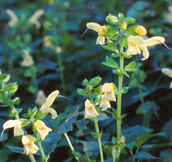
 Salvia nipponica Labiatae
Salvia nipponica Labiatae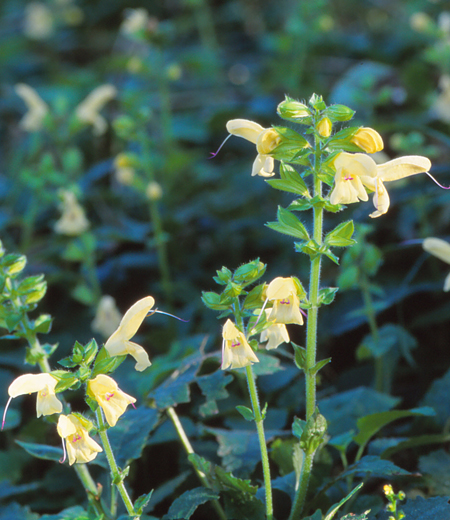 Perennial herbs (grow for several years from their same root system) found under tree shades and streamside in mountains. The Japanese name Kibana-aki-kiri literally meaning yellow flower autumn empress tree was named because it blooms flower in autumn resembling the flower of empress tree. There are many flowers resembles flowers of empress trees but this plant have yellow flower. Leaves are hastate shaped like a spearhead with flaring pointed lobes at the base. Length is 5 to 10 cm with toothed margins (edges of leaves are like a teeth of saw). Flowers are 2..5 to 3..5 cm and bloom many flowers in tiers create 10 to 20 cm long flower spikes. The upper petal straight up and lower petal lobed in three and pistil protrude long from the center of petals because this makes it easier to put pollen to the back of insects come for nectar. When insects stick their head in the flower, anther with pollen tilt downward.
Perennial herbs (grow for several years from their same root system) found under tree shades and streamside in mountains. The Japanese name Kibana-aki-kiri literally meaning yellow flower autumn empress tree was named because it blooms flower in autumn resembling the flower of empress tree. There are many flowers resembles flowers of empress trees but this plant have yellow flower. Leaves are hastate shaped like a spearhead with flaring pointed lobes at the base. Length is 5 to 10 cm with toothed margins (edges of leaves are like a teeth of saw). Flowers are 2..5 to 3..5 cm and bloom many flowers in tiers create 10 to 20 cm long flower spikes. The upper petal straight up and lower petal lobed in three and pistil protrude long from the center of petals because this makes it easier to put pollen to the back of insects come for nectar. When insects stick their head in the flower, anther with pollen tilt downward.
●Season Early September to about Mid October
●Height about 20 to 40 cm
●Place Trail 4, Oku-Takao -
Clinopodium chinense var. parviforum Labiatae
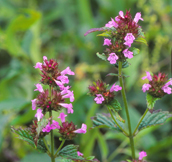
 Clinopodium chinense var. parviforum Labiatae
Clinopodium chinense var. parviforum Labiatae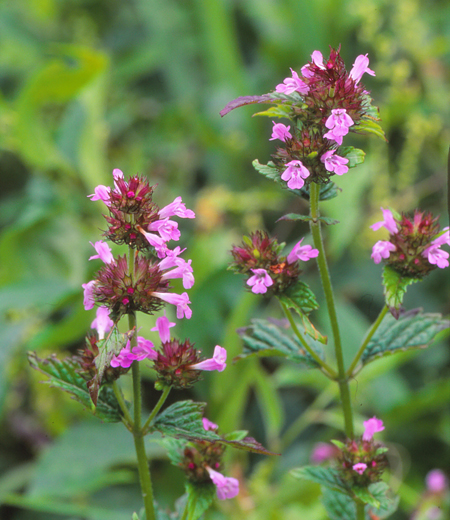 Perennial herbs (grow for several years from their same root system) found in sunny grasslands and on roadside in mountains. Stems are square cross-sectional and grow upright with hair facing downward. Flowers bloom covering at the tips of stems or petioles of leaves resembling wheels, hence the Japanese name Kuruma-bana literally meaning wheel flower. Flowers are 0.8 to 1 cm long, bright red-purple and lower petals are larger than the upper ones. Lower petal is lobed in three and has red spots in the center of flowers. Calyx is red-purple with hair. Leaves are 3 to 7 cm long, 1..5 to 4 cm width, elongated egg-shaped and opposite. Have hair along the leaf veins on the back of leaves toothed margins (edges of leaves are like a teeth of saw). Have 1 cm long petioles.
Perennial herbs (grow for several years from their same root system) found in sunny grasslands and on roadside in mountains. Stems are square cross-sectional and grow upright with hair facing downward. Flowers bloom covering at the tips of stems or petioles of leaves resembling wheels, hence the Japanese name Kuruma-bana literally meaning wheel flower. Flowers are 0.8 to 1 cm long, bright red-purple and lower petals are larger than the upper ones. Lower petal is lobed in three and has red spots in the center of flowers. Calyx is red-purple with hair. Leaves are 3 to 7 cm long, 1..5 to 4 cm width, elongated egg-shaped and opposite. Have hair along the leaf veins on the back of leaves toothed margins (edges of leaves are like a teeth of saw). Have 1 cm long petioles.
●Season Late July to about Mid September
●Height about 20 to 80 cm
●Place Ura-Takao, Oku-Takao, Kita-Takao -
Chelonopsis moschata Labiatae
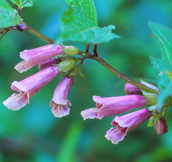
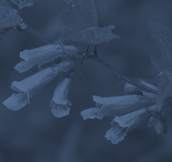 Chelonopsis moschata Labiatae
Chelonopsis moschata Labiatae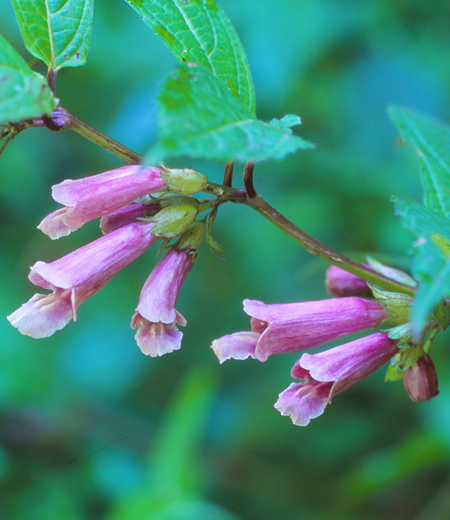 Perennial herbs (grow for several years from their same root system) found in wet area including forest edges in mountains. Have wonderful scent when shaking leaves or stems that is like the scent of musk, hence the Japanese name Jyako-so literally meaning musk plant. Flowers are 3..5 to 4 cm tubular and lip shaped at tips. The upper petal is short and the lower petal lobed in three and the center one is large. One to three flowers grow from petioles and bloom as if it is hiding from leaves. Color is red-purple to light red-purple. Leaves are 10 to 20 cm long, 3 to 10 cm width, elongated oval-shaped with pointed tip with toothed margins (edges of leaves are like a teeth of saw). Petioles are about 1 cm long and grow opposite. After flowering, produce four mericaps (fruits split into some parts).
Perennial herbs (grow for several years from their same root system) found in wet area including forest edges in mountains. Have wonderful scent when shaking leaves or stems that is like the scent of musk, hence the Japanese name Jyako-so literally meaning musk plant. Flowers are 3..5 to 4 cm tubular and lip shaped at tips. The upper petal is short and the lower petal lobed in three and the center one is large. One to three flowers grow from petioles and bloom as if it is hiding from leaves. Color is red-purple to light red-purple. Leaves are 10 to 20 cm long, 3 to 10 cm width, elongated oval-shaped with pointed tip with toothed margins (edges of leaves are like a teeth of saw). Petioles are about 1 cm long and grow opposite. After flowering, produce four mericaps (fruits split into some parts).
●Season Mid August to about Mid September
●Height about 60 cm to 1 m
●Place Trail 6, Ura-Takao -
Metaplexis japonica (Rough Potato) Asclepiadaceae
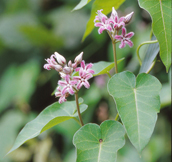
 Metaplexis japonica (Rough Potato) Asclepiadaceae
Metaplexis japonica (Rough Potato) Asclepiadaceae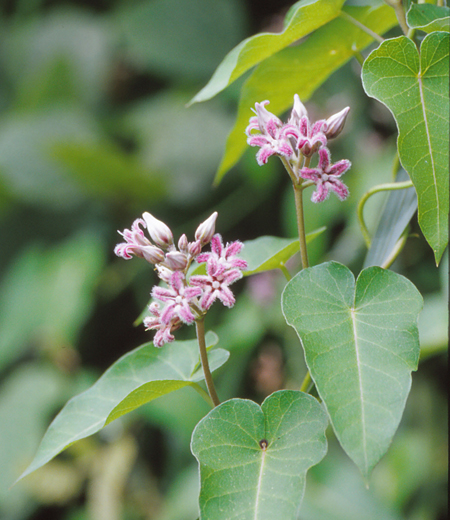 Perennial vines found in sunny grassland and forest edge. Prefer dry environment and grow by extending rhizomes. Twine adjacent plants but does not grow that tall. Flowers are star-shaped, about 1 cm in diameter and have curled edge petals. The actual color is light purple but with hairy white center, the entire flowers look white. Flower stalks grow from the axils of leaves and bloom several flowers. Leaves are long heart-shaped with pointed tip, about 5 to 10 cm long and the reverse side is whitish green. Have white juice when folding leaves or stems. In autumn, bear elongated potato-like fruits, about 10 cm long and about 2 cm wide and split open vertically when ripe. Seeds with silk-like long strings are flown by the wind.
Perennial vines found in sunny grassland and forest edge. Prefer dry environment and grow by extending rhizomes. Twine adjacent plants but does not grow that tall. Flowers are star-shaped, about 1 cm in diameter and have curled edge petals. The actual color is light purple but with hairy white center, the entire flowers look white. Flower stalks grow from the axils of leaves and bloom several flowers. Leaves are long heart-shaped with pointed tip, about 5 to 10 cm long and the reverse side is whitish green. Have white juice when folding leaves or stems. In autumn, bear elongated potato-like fruits, about 10 cm long and about 2 cm wide and split open vertically when ripe. Seeds with silk-like long strings are flown by the wind.
●Season about August
●Height Vine
●Place Trail 1, Trail 6, Mt. Inari, Jyataki, Ura-Takao, Minami-Takao -
Marsdenia tomentosa Asclepiadaceae
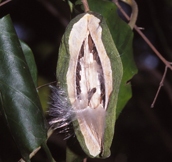
 Marsdenia tomentosa Asclepiadaceae
Marsdenia tomentosa Asclepiadaceae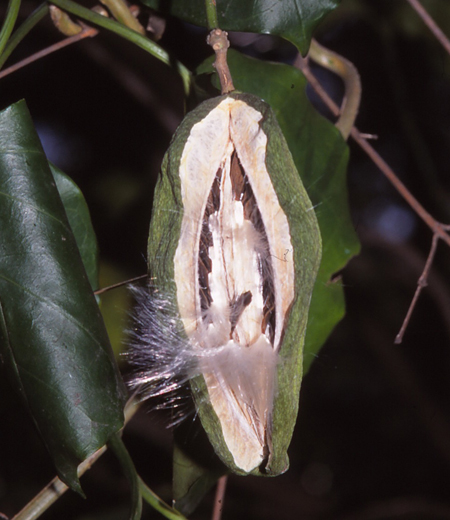 Perennials vines found in forests throughout Mt. Takao and also known as food plants for parantica sita, a beautiful butterfly. Japanese name Kijyo-Ran literally meaning female devil orchid was named because seeds with white long hair that pop when ripe resembling female devil swinging white hair. Flowers are tubular and bell-shaped, about 4 mm long, light yellowish white and many radiate from leaves. Leaves are almost round-shaped with pointed tip, about 7 to 12 cm in diameter and shiny surface. Stems are thick and green but woody at the base and twine adjacent plants. Fruits are green, oval-shaped and about 13 to 15 cm long. Ripe on the following autumn, split open vertically and seeds are flown by the wind.
Perennials vines found in forests throughout Mt. Takao and also known as food plants for parantica sita, a beautiful butterfly. Japanese name Kijyo-Ran literally meaning female devil orchid was named because seeds with white long hair that pop when ripe resembling female devil swinging white hair. Flowers are tubular and bell-shaped, about 4 mm long, light yellowish white and many radiate from leaves. Leaves are almost round-shaped with pointed tip, about 7 to 12 cm in diameter and shiny surface. Stems are thick and green but woody at the base and twine adjacent plants. Fruits are green, oval-shaped and about 13 to 15 cm long. Ripe on the following autumn, split open vertically and seeds are flown by the wind.
●Season August to about September
●Height Vine
●Place Trail 1 to 6, Mt. Inari, Jyataki, Ura-Takao, Kita-Takao -
Cynanchum sublanceolatum var.macranthum Asclepiadaceae
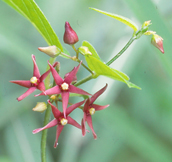
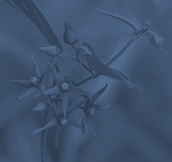 Cynanchum sublanceolatum var.macranthum Asclepiadaceae
Cynanchum sublanceolatum var.macranthum Asclepiadaceae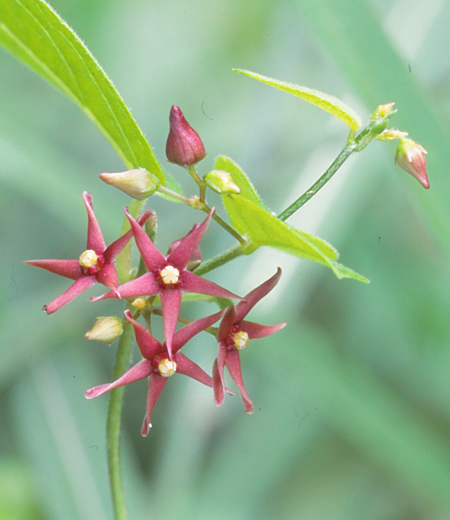 Perennial vines found in sunny grassland and on riverbank. Stems grow long and twine adjacent plants. Japanese name, Kobano-kamome-zuru literally meaning small leaf gull vine was named because opposite leaves resemble wings of gulls. Flowers are star-shaped, about 6 to 8 mm in diameter and blooms several flowers randomly on flower stalks grow from the axils of leaves. Tips of flowers are mostly twisted and dark purple like asteroids in the ocean. Leaves are elongated oval-shaped, about 4 to 5 cm long with pointed tip and have short leave stalks. After flowering, bear elongated fruits, about 5 to 7 cm long, about 7mm wide with pointed tip. Split open when ripe and release seeds with white cotton-like hair.
Perennial vines found in sunny grassland and on riverbank. Stems grow long and twine adjacent plants. Japanese name, Kobano-kamome-zuru literally meaning small leaf gull vine was named because opposite leaves resemble wings of gulls. Flowers are star-shaped, about 6 to 8 mm in diameter and blooms several flowers randomly on flower stalks grow from the axils of leaves. Tips of flowers are mostly twisted and dark purple like asteroids in the ocean. Leaves are elongated oval-shaped, about 4 to 5 cm long with pointed tip and have short leave stalks. After flowering, bear elongated fruits, about 5 to 7 cm long, about 7mm wide with pointed tip. Split open when ripe and release seeds with white cotton-like hair.
●Season July to about September
●Height Vine
●Place Trail 4, Oku-Takao -
Tripterospermum japonicum Gentianaceae
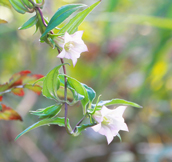
 Tripterospermum japonicum Gentianaceae
Tripterospermum japonicum Gentianaceae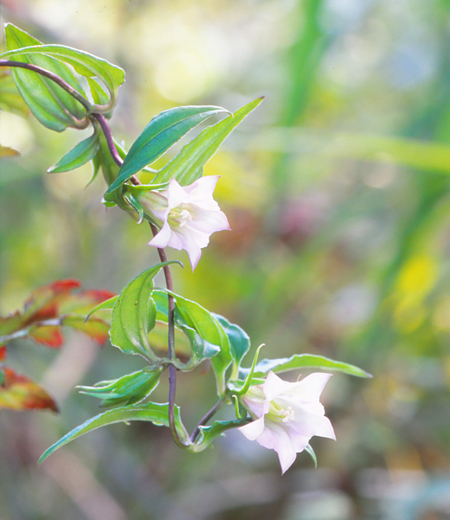 Perennial herbs vines (grow for several years from their same root system) found under trees on hills in mountains. Purplish vines trail on ground and sometime grow twine adjacent plants and become 40 to 80 cm long. Bloom one trumpet-like 2..5 to 3 cm long flower at the base of leaves and normally light purple, but the ones in Mt. Takao are whitish flowers. Tips of petals are lobed in five and give stamens surround a pistil. Leaves are 3 to 5 cm long, elongated egg-shaped and opposite. Have three veins on surface of leaves and purplish on the back. After flowering, bear oval-shaped fruis at the tips of dead flowers. Style of pistil remains and ripen to red-purple.
Perennial herbs vines (grow for several years from their same root system) found under trees on hills in mountains. Purplish vines trail on ground and sometime grow twine adjacent plants and become 40 to 80 cm long. Bloom one trumpet-like 2..5 to 3 cm long flower at the base of leaves and normally light purple, but the ones in Mt. Takao are whitish flowers. Tips of petals are lobed in five and give stamens surround a pistil. Leaves are 3 to 5 cm long, elongated egg-shaped and opposite. Have three veins on surface of leaves and purplish on the back. After flowering, bear oval-shaped fruis at the tips of dead flowers. Style of pistil remains and ripen to red-purple.
●Season Early September to about Early October
●Height Vines
●Place Trail 6, Mt. Inari, Oku-Takao -
Lysimachia clethroides(Gooseneck Loosestrife) Primulaceae
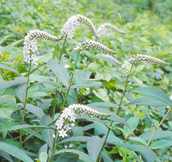
 Lysimachia clethroides(Gooseneck Loosestrife) Primulaceae
Lysimachia clethroides(Gooseneck Loosestrife) Primulaceae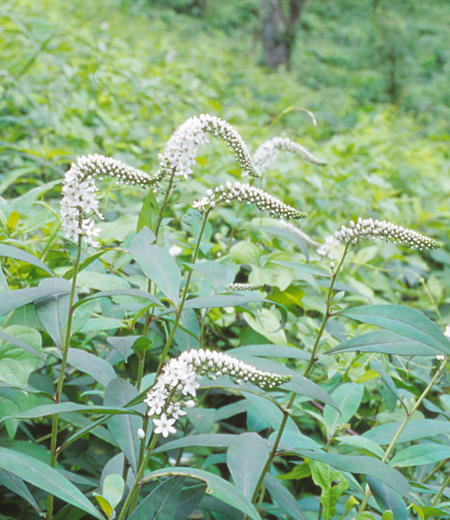 Perennial herbs found in sunny grassland on hills. Grows by extending rhizomes. Stems grow upright without branches. Entire plants have irregularly short white hairs and more reddish at the base. Flowers are 1 cm in diameter, star-shaped, white and blooms with about 10 to 30 cm long trusses of flowers. Japanese name Oka-toranoo literally meaning hills and tigers’ tails was named because its trusses resemble the tails of tigers and they grow on hills. Flowers bloom from the bottom and the tips drop to the same direction. Leaves are about 6 to 13 cm long, elongated oval-shape with pointed tip, short hair on both sides and alternate. After flowering, bear fruits and dropping stems become upright.
Perennial herbs found in sunny grassland on hills. Grows by extending rhizomes. Stems grow upright without branches. Entire plants have irregularly short white hairs and more reddish at the base. Flowers are 1 cm in diameter, star-shaped, white and blooms with about 10 to 30 cm long trusses of flowers. Japanese name Oka-toranoo literally meaning hills and tigers’ tails was named because its trusses resemble the tails of tigers and they grow on hills. Flowers bloom from the bottom and the tips drop to the same direction. Leaves are about 6 to 13 cm long, elongated oval-shape with pointed tip, short hair on both sides and alternate. After flowering, bear fruits and dropping stems become upright.
●Season Mid-June to about Mid-July
●Height about 60 cm to 1 m
●Place Trail 5, Mt. Inari, Ura-Takao, Oku-Takao -
Pyrola japonica(Shinleaf) Pyrolaceae
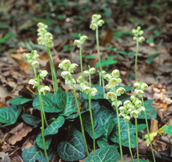
 Pyrola japonica(Shinleaf) Pyrolaceae
Pyrola japonica(Shinleaf) Pyrolaceae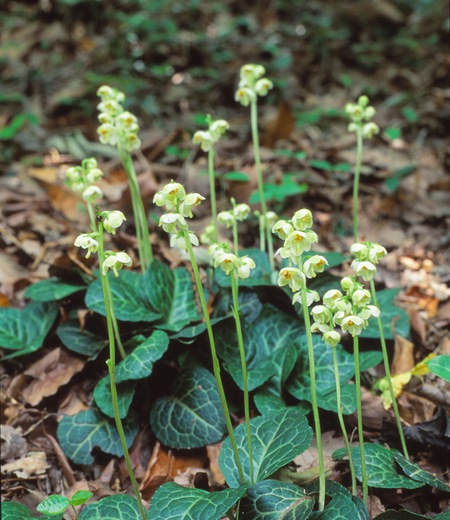 Perennials evergreen herbs found in bright woodland. Japanese name, Ichiyaku-So literally meaning one medicinal plant was named because they offer great effects as treatment herbs. Dried entire plants are used to cure beriberi and the extracts from its leaves are used to stop bleeding. At the tip of long upright stems, bloom three to ten drooping white flowers, about 1.2 to 1.5 cm long and resemble ume (Japanese apricot) flowers. Have five petals, curved pistils protrude and the tips of stamens have holes to release pollen. Leaves are about 3 to 6 cm long, about 2 to 4 wide, oval-shaped and mostly basal. Leave veins have lighter color and netlike appearance. Leaves are leathery with toothed margins. After flowering, remained pistils bear fruits in capsule and open when they are ripe.
Perennials evergreen herbs found in bright woodland. Japanese name, Ichiyaku-So literally meaning one medicinal plant was named because they offer great effects as treatment herbs. Dried entire plants are used to cure beriberi and the extracts from its leaves are used to stop bleeding. At the tip of long upright stems, bloom three to ten drooping white flowers, about 1.2 to 1.5 cm long and resemble ume (Japanese apricot) flowers. Have five petals, curved pistils protrude and the tips of stamens have holes to release pollen. Leaves are about 3 to 6 cm long, about 2 to 4 wide, oval-shaped and mostly basal. Leave veins have lighter color and netlike appearance. Leaves are leathery with toothed margins. After flowering, remained pistils bear fruits in capsule and open when they are ripe.
●Season Early June to about Early July
●Height about 15 to 20 cm
●Place Trail 3, Oku-Takao -
Chimaphila japonica Pyrolaceae
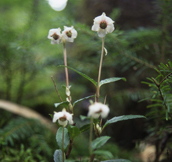
 Chimaphila japonica Pyrolaceae
Chimaphila japonica Pyrolaceae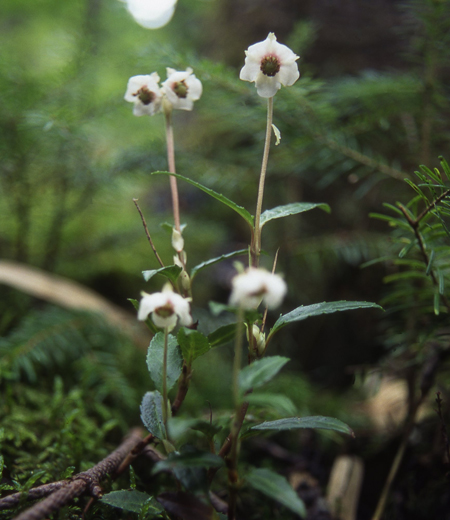 Perennials evergreen herbs found on dry hills and in woods. Japanese name Ume-Kasa-So literally meaning ume (Japanese apricot) umbrella plant was named because flowers resemble ume (Japanese apricot) and drooping flowers are like umbrellas. Flowers are about 1 cm in diameter and have 5 white petals with light red center. Normally bloom one flower per stem but sometimes two. Five elongated calyx are under each petals. Leaves are about 2 to 3.5 cm long, oval-shaped with pointed tip and have white mottling along veins. Leathery and shiny leaves with toothed margins and normally two or three leaves alternate. After flowering, bear flattened round-shaped fruits at the tips of stems and open when they are ripe.
Perennials evergreen herbs found on dry hills and in woods. Japanese name Ume-Kasa-So literally meaning ume (Japanese apricot) umbrella plant was named because flowers resemble ume (Japanese apricot) and drooping flowers are like umbrellas. Flowers are about 1 cm in diameter and have 5 white petals with light red center. Normally bloom one flower per stem but sometimes two. Five elongated calyx are under each petals. Leaves are about 2 to 3.5 cm long, oval-shaped with pointed tip and have white mottling along veins. Leathery and shiny leaves with toothed margins and normally two or three leaves alternate. After flowering, bear flattened round-shaped fruits at the tips of stems and open when they are ripe.
●Season Early June to about Early July
●Height about 10 to 15 cm
●Place Trail 5 -
Spuriopimpinella calycina Umbelliferae
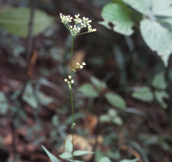
 Spuriopimpinella calycina Umbelliferae
Spuriopimpinella calycina Umbelliferae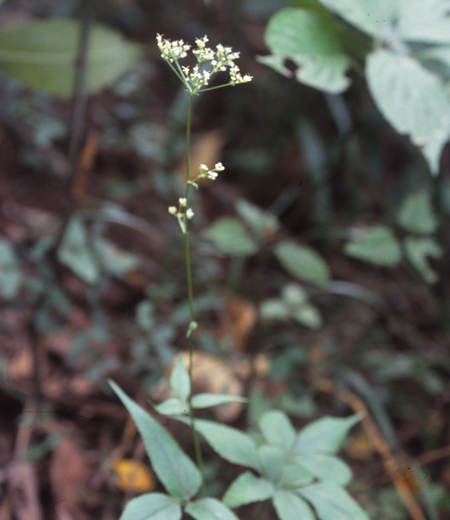 Perennial herbs (grow for several years from their same root system) found in forests in mountains. The Japanese name Kano-tume-so literally meaning nail of deer plant was named because the root of this plant resembles nail of deer. This is also called as Dake-zeri literally meaning Japanese parsley in mountains. Grow upright thin stems with many branches and bloom one flower about 3 to 5 in diameter each branch. Have five petals curled inward and stamen protrudes long. Leaves are 3 to 14 cm long and biternate compound leaf, a leaf with three leaflets sub divided into three different sections on one long petiole. These three leaves are alternate on petiole. The shape of leaves is elongated egg-shaped with pointed tip and toothed margins (edges of leaves are like a teeth of saw). Have hair along leaf veins.
Perennial herbs (grow for several years from their same root system) found in forests in mountains. The Japanese name Kano-tume-so literally meaning nail of deer plant was named because the root of this plant resembles nail of deer. This is also called as Dake-zeri literally meaning Japanese parsley in mountains. Grow upright thin stems with many branches and bloom one flower about 3 to 5 in diameter each branch. Have five petals curled inward and stamen protrudes long. Leaves are 3 to 14 cm long and biternate compound leaf, a leaf with three leaflets sub divided into three different sections on one long petiole. These three leaves are alternate on petiole. The shape of leaves is elongated egg-shaped with pointed tip and toothed margins (edges of leaves are like a teeth of saw). Have hair along leaf veins.
●Season Early September to about Mid October
●Height about 50 cm to 1 m
●Place Oku-Takao -
Panax japonicus (Japanese Ginseng) Araliaceae
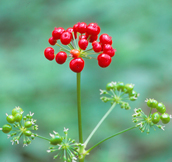
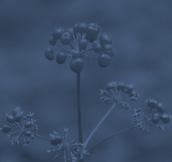 Panax japonicus (Japanese Ginseng) Araliaceae
Panax japonicus (Japanese Ginseng) Araliaceae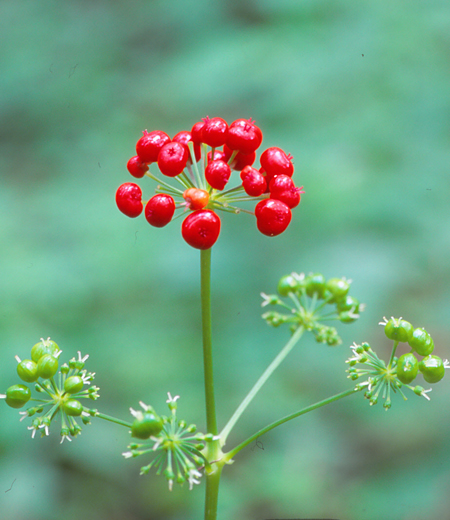 Perennial herbs found in hilly grassland and woods. A part of ginseng family and Japanese name Tochiba-Ninjin literally meaning Tochinoki (aesculus turbinata) ginseng) is named because leaves resemble Tochinoki (Aesculus turbinata). Also called as Chikusetsu Ninjin literally meaning bamboo nodes ginseng because rhizomes are thick with distinct nodes resembling bamboo. Rhizomes are used as medicine for coughing, sputum and stomachaches. Flowers are about 3 mm in diameter and light green. On the tip of long flower stalks, flowers are densely arranged in umbels. Have five palmate leaves and whorls in three or five on the tip of long leave stem. Soft texture leaves with irregularly toothed margins. After flowering, bears a red fruit per flower, one about 5 to 7 mm in diameter and sometimes with a black top.
Perennial herbs found in hilly grassland and woods. A part of ginseng family and Japanese name Tochiba-Ninjin literally meaning Tochinoki (aesculus turbinata) ginseng) is named because leaves resemble Tochinoki (Aesculus turbinata). Also called as Chikusetsu Ninjin literally meaning bamboo nodes ginseng because rhizomes are thick with distinct nodes resembling bamboo. Rhizomes are used as medicine for coughing, sputum and stomachaches. Flowers are about 3 mm in diameter and light green. On the tip of long flower stalks, flowers are densely arranged in umbels. Have five palmate leaves and whorls in three or five on the tip of long leave stem. Soft texture leaves with irregularly toothed margins. After flowering, bears a red fruit per flower, one about 5 to 7 mm in diameter and sometimes with a black top.
●Season Mid-June to about Mid-July
●Height about 50 to 80 cm
●Place Trail 5, Kita-Takao -
Impatiens noli-tangere Balsaminaceae
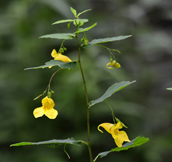
 Impatiens noli-tangere Balsaminaceae
Impatiens noli-tangere Balsaminaceae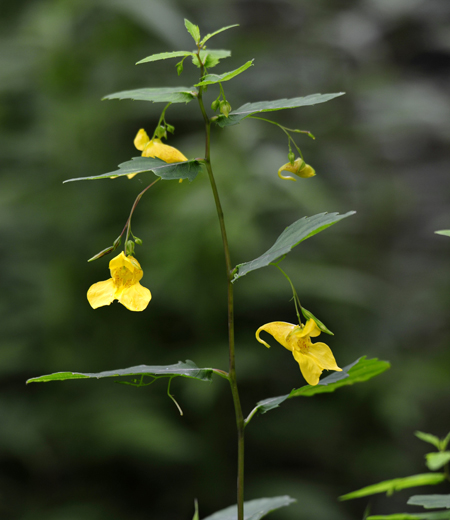 Annual herbs found in wet areas near streams and waterside in mountains. Thin inflorescence (flower stems without leaves) are dropping and bloom three to five light yellow flowers like triangular hat-shaped. Flowers are like the yellow version of impatiens textori but the spur of this plant curls down not in spiral shape. Tips of leaves are not pointed and less toothed margins (edges of leaves are like a teeth of saw). Flowers are 3 to 4 cm long and tubular shaped and tips open like lips. Petals have red-brown spots in the center of flowers. Leaves are 4 to 8 cm long, 2 to 5 cm width elongated oval-shaped with toothed margins and alternate on 2 to 5 cm petioles. After flowering, bear fleshy fruits and pop seeds at a touch when ripen.
Annual herbs found in wet areas near streams and waterside in mountains. Thin inflorescence (flower stems without leaves) are dropping and bloom three to five light yellow flowers like triangular hat-shaped. Flowers are like the yellow version of impatiens textori but the spur of this plant curls down not in spiral shape. Tips of leaves are not pointed and less toothed margins (edges of leaves are like a teeth of saw). Flowers are 3 to 4 cm long and tubular shaped and tips open like lips. Petals have red-brown spots in the center of flowers. Leaves are 4 to 8 cm long, 2 to 5 cm width elongated oval-shaped with toothed margins and alternate on 2 to 5 cm petioles. After flowering, bear fleshy fruits and pop seeds at a touch when ripen.
●Season Late July to about Mid September
●Height about 40 to 80 cm
●Place Trail 1, Trail 3 to 6, Jyataki, Ura-Takao -
Impatiens textori Balsaminaceae
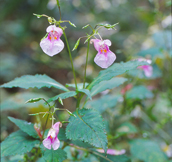
 Impatiens textori Balsaminaceae
Impatiens textori Balsaminaceae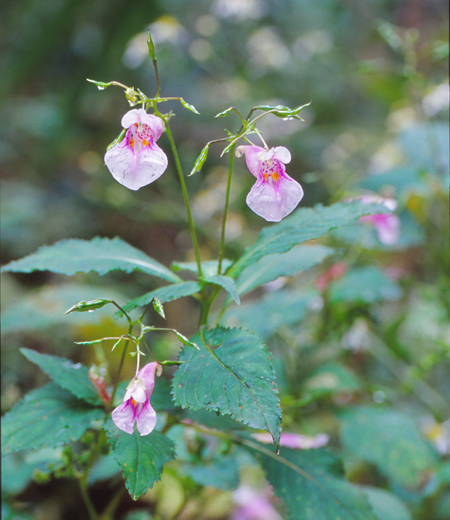 Annual herbs found in wet roadside near streams and waterside. Peduncles grow from petioles and bloom several red-purple flowers. The Japanese name Tsurifune-so was named after the dropping bell-like flowers resembling flower pod called tsurifune. Flowers are 3 to 4 cm and tips of petals open vertically. Have three petals and calyx and one of calyx are large sac-shaped and have spur (pouch like part on the back of petals) curled on the back. Leaves are 5 to 13 cm long, 2 to 6 cm width diamond shaped andand rhomboid oval shaped with long petioles, pointed tips with fine toothed margins (edges of leaves are like a teeth of saw). Stems are reddish and have thick nodes. After flowering, bear 1 to 2 cm long fruits and pop seeds at a touch when ripen.
Annual herbs found in wet roadside near streams and waterside. Peduncles grow from petioles and bloom several red-purple flowers. The Japanese name Tsurifune-so was named after the dropping bell-like flowers resembling flower pod called tsurifune. Flowers are 3 to 4 cm and tips of petals open vertically. Have three petals and calyx and one of calyx are large sac-shaped and have spur (pouch like part on the back of petals) curled on the back. Leaves are 5 to 13 cm long, 2 to 6 cm width diamond shaped andand rhomboid oval shaped with long petioles, pointed tips with fine toothed margins (edges of leaves are like a teeth of saw). Stems are reddish and have thick nodes. After flowering, bear 1 to 2 cm long fruits and pop seeds at a touch when ripen.
●Season Early September to about Mid October
●Height about 40 to 80 cm
●Place Trail 1, Trail 4, Trail 6, Ura-Takao, Oku-Takao, Minami-Takao -
Euphorbia pekinensis Euphorbiaceae
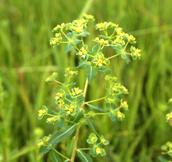
 Euphorbia pekinensis Euphorbiaceae
Euphorbia pekinensis Euphorbiaceae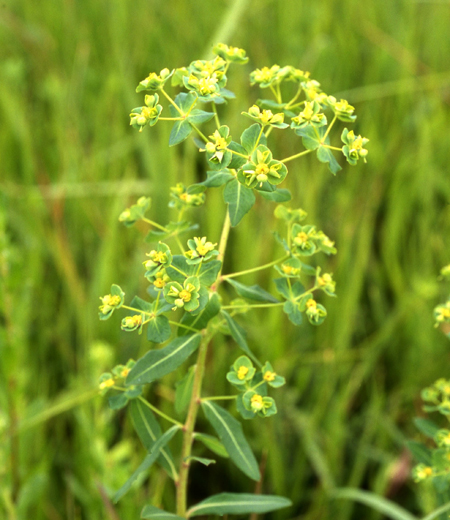 Perennial herbs (grow for several years from their same root system) found in sunny grasslands in mountains and on hills. Is a family of euphorbiaceae, the Japanese name Taka-todai literally meaning tall lighthouse was named because the shape of this plant is tall like the lighthouse used in the past. Leaves are elongated oval shaped, 3 to 8 cm long and in whorls of five (three or more leaves around the stem at each node) and several peduncles grow from the center and bloom yellow-green flowers. Flowers are like buds covered by bracts (transformed leaves at the base of flower) and have no petals and calyx. Have four yellow protrusions called leaf glands that produce nectar and have some stamens and one pistil inside. Have white and poisonous juice when cutting leaves and stems causing skin irritation at a touch and vomiting when leaves are eaten by mistake. Fruits have red wart-like protrusions and split open and drop seeds when ripen. Leaves turn red in autumn.
Perennial herbs (grow for several years from their same root system) found in sunny grasslands in mountains and on hills. Is a family of euphorbiaceae, the Japanese name Taka-todai literally meaning tall lighthouse was named because the shape of this plant is tall like the lighthouse used in the past. Leaves are elongated oval shaped, 3 to 8 cm long and in whorls of five (three or more leaves around the stem at each node) and several peduncles grow from the center and bloom yellow-green flowers. Flowers are like buds covered by bracts (transformed leaves at the base of flower) and have no petals and calyx. Have four yellow protrusions called leaf glands that produce nectar and have some stamens and one pistil inside. Have white and poisonous juice when cutting leaves and stems causing skin irritation at a touch and vomiting when leaves are eaten by mistake. Fruits have red wart-like protrusions and split open and drop seeds when ripen. Leaves turn red in autumn.
●Season Mid June to about Late August
●Height about 50 to 80 cm
●Place Trail 5, Mt. Inari, Oku-Takao -
Boenninghausenia japonica Rutaceae
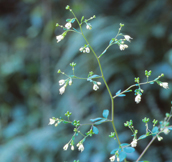
 Boenninghausenia japonica Rutaceae
Boenninghausenia japonica Rutaceae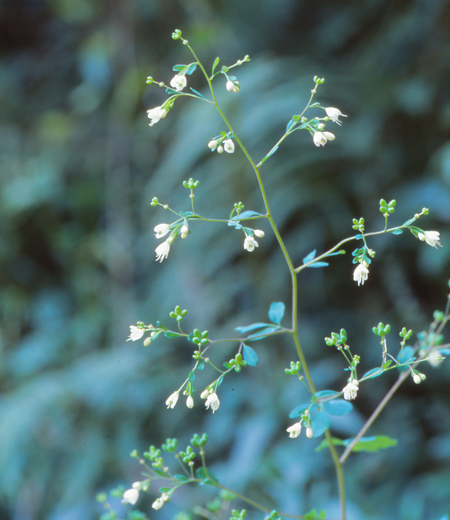 Perennial herbs (grow for several years from their same root system) found in tree shades and streamside in mountain. This is only grass plant in rutaceae native to Japan. Have half-transparent oil spots that are unique to plants in rutaceae family. Have strong scent and often used as anti-insect agent. Flowers are 5 mm in diameter with four petals and stamen protrude long. Color is white and bloom many on inflorescence. The Japanese name Matsukaze-so litearlly meaning pine breeze plant was named because it resemble pine branch looking wijnruit which is also a grass plants in rutaceae family native to Southern Europe. Leaves are tripinnately compound leaf, a set of three leaves divided into three branches. Each leaf is upside down egg-shaped and 1 to 2..5 cm long. Texture is soft and white on the back. After flowering, bear 3 mm long fruits split into four. Pop when ripen and some seeds inside.
Perennial herbs (grow for several years from their same root system) found in tree shades and streamside in mountain. This is only grass plant in rutaceae native to Japan. Have half-transparent oil spots that are unique to plants in rutaceae family. Have strong scent and often used as anti-insect agent. Flowers are 5 mm in diameter with four petals and stamen protrude long. Color is white and bloom many on inflorescence. The Japanese name Matsukaze-so litearlly meaning pine breeze plant was named because it resemble pine branch looking wijnruit which is also a grass plants in rutaceae family native to Southern Europe. Leaves are tripinnately compound leaf, a set of three leaves divided into three branches. Each leaf is upside down egg-shaped and 1 to 2..5 cm long. Texture is soft and white on the back. After flowering, bear 3 mm long fruits split into four. Pop when ripen and some seeds inside.
●Season Late August to about Early October
●Height about 50 to 80 cm
●Place Trail 1 to 6, Ura-Takao, Oku-Takao -
Geranium wilfordii Geraniaceae
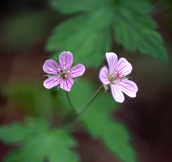
 Geranium wilfordii Geraniaceae
Geranium wilfordii Geraniaceae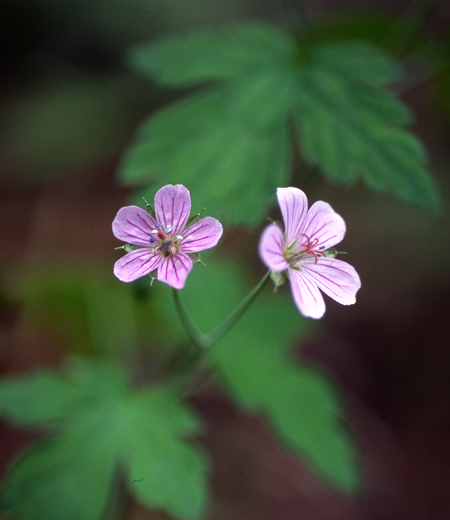 Perennial herbs (grow for several years from their same root system) found in grasslands and at forest edges in mountains and fields. In Mt. Takao, found in areas along steams in Mt. Takao. The lower part of stems bent on the ground and the upper part grow upright. Have ground facing hair on leaves, stems and petioles. The Japanese name Mitsuba-furo has the word mitsuba meaning three leaves but it is actually one petal lobed deep in three. Leaves are 3 t o10 cm long and opposite. Flowers are light red-purple with red lines. Similar geranium thunbergii have sticky tentaculars that is different from this plant. Calyx with long hair is called Takao-furo named after Mt. Takao.
Perennial herbs (grow for several years from their same root system) found in grasslands and at forest edges in mountains and fields. In Mt. Takao, found in areas along steams in Mt. Takao. The lower part of stems bent on the ground and the upper part grow upright. Have ground facing hair on leaves, stems and petioles. The Japanese name Mitsuba-furo has the word mitsuba meaning three leaves but it is actually one petal lobed deep in three. Leaves are 3 t o10 cm long and opposite. Flowers are light red-purple with red lines. Similar geranium thunbergii have sticky tentaculars that is different from this plant. Calyx with long hair is called Takao-furo named after Mt. Takao.
●Season Late August to about Mid October
●Height about 30 to 80 cm
●Place Trail 6, Oku-Takao, Kita-Takao -
Pueraria lobata(kudzu) Leguminosae
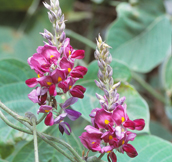
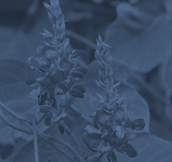 Pueraria lobata(kudzu) Leguminosae
Pueraria lobata(kudzu) Leguminosae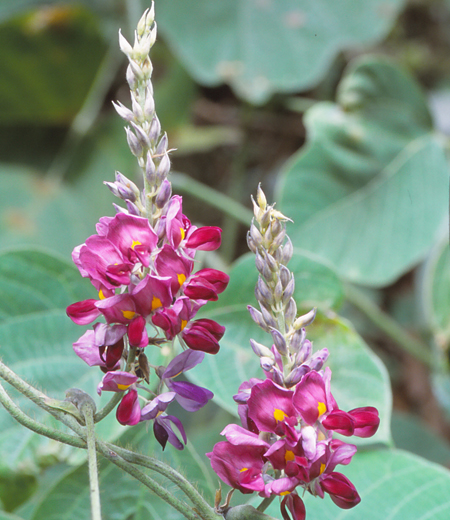 Perennial vines (grow for several years from their same root system) found in mountains and is a part of seven autumn leaves. Grow by twining around adjacent plants up to 10 m. Roots are thick and include high concentration of starch that makes powdered arrowroot. This was mainly from Kuzu area of Nara prefecture, hence the Japanese name kudzu. Also used in dry as a medicine for cold, kakkonto. Bloom many flowers on 10 to 20 cm inflorescence (flower stems without leaves). Flowers are 1..5 to 2 cm long and red-purple. Bloom from the bottom and slightly sweet scented. Three leaves create compound leaves and each leaf is 10 to 15 cm long. Roundy egg-shaped and some lobed in two or three and have white hair densely on the back of leaves. Young vine, stems, flowers or buds can be eaten as tempura.
Perennial vines (grow for several years from their same root system) found in mountains and is a part of seven autumn leaves. Grow by twining around adjacent plants up to 10 m. Roots are thick and include high concentration of starch that makes powdered arrowroot. This was mainly from Kuzu area of Nara prefecture, hence the Japanese name kudzu. Also used in dry as a medicine for cold, kakkonto. Bloom many flowers on 10 to 20 cm inflorescence (flower stems without leaves). Flowers are 1..5 to 2 cm long and red-purple. Bloom from the bottom and slightly sweet scented. Three leaves create compound leaves and each leaf is 10 to 15 cm long. Roundy egg-shaped and some lobed in two or three and have white hair densely on the back of leaves. Young vine, stems, flowers or buds can be eaten as tempura.
●Season Mid July to about Mid September
●Height Vines
●Place Trail 1, Trail 4, Tail 6, Jyataki and Ura-Takao -
Desmodium oldhamii Leguminosae
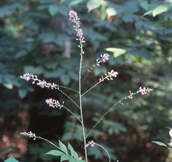
 Desmodium oldhamii Leguminosae
Desmodium oldhamii Leguminosae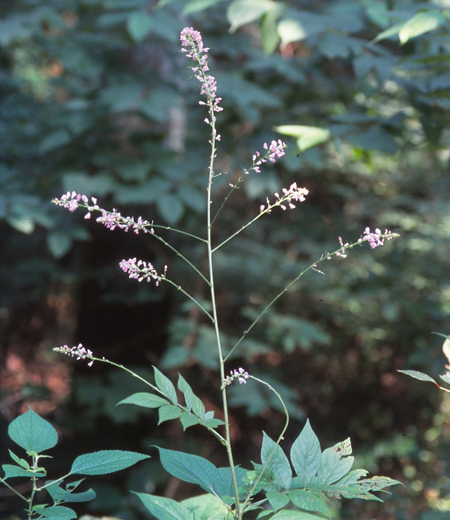 Perennial herbs (grow for several years from their same root system) found in forests in mountains. Fine hair on stems is sticky at a touch. Flowers are 1 cm long, pink and blooms randomly on flower stems (flower stems without leaves) are about 30 cm grow from tips of stems or petioles. Five to seven leaves alternate on stems like feather of birds. Each leaf of compound leaves is long egg-shaped and about 10 cm. The Japanese name Fuji-kanzo literally meaning wisteria sweetroot was named because flowers resemble wisteria and leaves resemble sweetroot. After flowering bear fruits called loment, an indehiscent legume (break apart into indehiscent, seed-bearing segment). Ripen fruits are brown and have densely hook-shaped hair which is carried by animals or clothes. The shape of loment is two-segmented half-moon shaped and about 2cm long, twice as large as the size of the similar plant desmodium podocarpum subsp. oxyphyllum.
Perennial herbs (grow for several years from their same root system) found in forests in mountains. Fine hair on stems is sticky at a touch. Flowers are 1 cm long, pink and blooms randomly on flower stems (flower stems without leaves) are about 30 cm grow from tips of stems or petioles. Five to seven leaves alternate on stems like feather of birds. Each leaf of compound leaves is long egg-shaped and about 10 cm. The Japanese name Fuji-kanzo literally meaning wisteria sweetroot was named because flowers resemble wisteria and leaves resemble sweetroot. After flowering bear fruits called loment, an indehiscent legume (break apart into indehiscent, seed-bearing segment). Ripen fruits are brown and have densely hook-shaped hair which is carried by animals or clothes. The shape of loment is two-segmented half-moon shaped and about 2cm long, twice as large as the size of the similar plant desmodium podocarpum subsp. oxyphyllum.
●Season August to about September
●Height about 50 cm to 1.5 m
●Place Trail 1 to 2, Trail 4 to 6, Mt. Inari, Ura-Takao, Oku-Takao -
Agrimonia pilosa Rosaceae
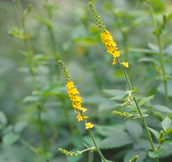
 Agrimonia pilosa Rosaceae
Agrimonia pilosa Rosaceae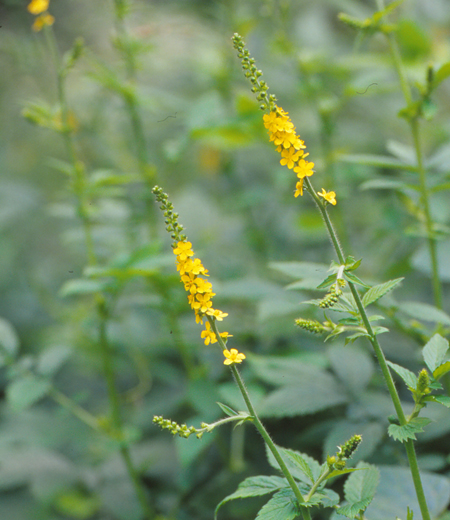 Perennial herbs (grow for several years from their same root system) found in wet grasslands and at roadside in mountains. Stems grow upright with hair. 10 to 20 cm flower stems grow from petioles and bloom small white flowers in flower spikes. This resemble gold mizuhiki, the decorative two tone paper cord (normally gold is used), hence the Japanese name Kin-mizuhiki literally meaning golden two tone paper cord decoration. Flowers are 0.7 to 1 cm in diameter with five petals and bloom from the bottom. Leaves are egg-like shape, 3 to 6 cm long. Five or nine leaves create feather of birds and alternate. Have many leaf glands on the back of leaves with toothed margins (edges of leaves are like a teeth of saw). After flowering, bear 3 cm long seeds. Fruits are hook-like bracts with many prickles and carried by sticking itself to animals and clothes.
Perennial herbs (grow for several years from their same root system) found in wet grasslands and at roadside in mountains. Stems grow upright with hair. 10 to 20 cm flower stems grow from petioles and bloom small white flowers in flower spikes. This resemble gold mizuhiki, the decorative two tone paper cord (normally gold is used), hence the Japanese name Kin-mizuhiki literally meaning golden two tone paper cord decoration. Flowers are 0.7 to 1 cm in diameter with five petals and bloom from the bottom. Leaves are egg-like shape, 3 to 6 cm long. Five or nine leaves create feather of birds and alternate. Have many leaf glands on the back of leaves with toothed margins (edges of leaves are like a teeth of saw). After flowering, bear 3 cm long seeds. Fruits are hook-like bracts with many prickles and carried by sticking itself to animals and clothes.
●Season Late July to about Late September
●Height about 50 cm to 1 m
●Place Trail 3, Ura-Takao, Oku-Takao -
Astilbe thunbergii Saxifragaceae
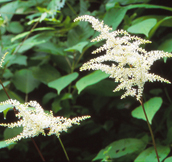
 Astilbe thunbergii Saxifragaceae
Astilbe thunbergii Saxifragaceae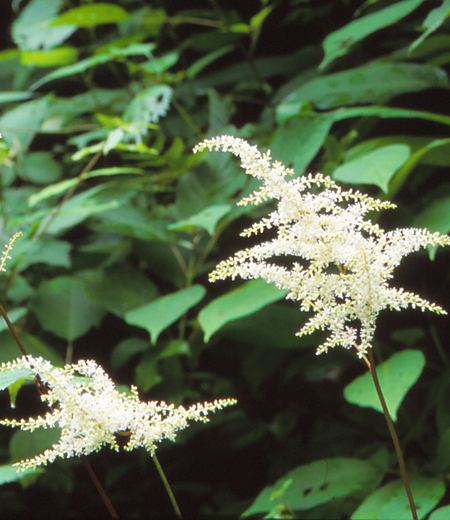 Perennial herbs (grow for several years from their same root system) found in sunny forests and grasslands in mountains. Thick underground stems are reddish and bloom in flower spikes like cimicifuga simplex (DC.) wormsk. ex turcz in ranunculaceae family, hence the Japanese name Aka-shouma literally meaning red cimicifuga simplex (DC.) wormsk. ex turcz but they are not similar at all. Bloom 3 mm long small white flowers on thin and 10 to 25 cm long flower branches on upper part of stems. Radical leaves are ternate compound leaves, a set of three leaves divided into three branches. Have brown hair on long petioles. The shape of leaves is elongated and 4 to 10 cm long and 2 to 4 width and with pointed tip and toothed margins (edges of leaves are like a teeth of saw). After flowering, bear 3 mm long cylindrical shape with pointed tip fruits. Turns brown when ripen and pop seeds.
Perennial herbs (grow for several years from their same root system) found in sunny forests and grasslands in mountains. Thick underground stems are reddish and bloom in flower spikes like cimicifuga simplex (DC.) wormsk. ex turcz in ranunculaceae family, hence the Japanese name Aka-shouma literally meaning red cimicifuga simplex (DC.) wormsk. ex turcz but they are not similar at all. Bloom 3 mm long small white flowers on thin and 10 to 25 cm long flower branches on upper part of stems. Radical leaves are ternate compound leaves, a set of three leaves divided into three branches. Have brown hair on long petioles. The shape of leaves is elongated and 4 to 10 cm long and 2 to 4 width and with pointed tip and toothed margins (edges of leaves are like a teeth of saw). After flowering, bear 3 mm long cylindrical shape with pointed tip fruits. Turns brown when ripen and pop seeds.
●Season Mid June to about Mid July
●Height about 40 to 80 cm
●Place Trail 1 to 5, Mt. Inari, Ura-Takao, Oku-Takao -
Astilbe microphylla Saxifragaceae
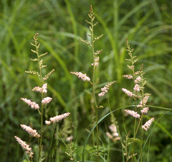
 Astilbe microphylla Saxifragaceae
Astilbe microphylla Saxifragaceae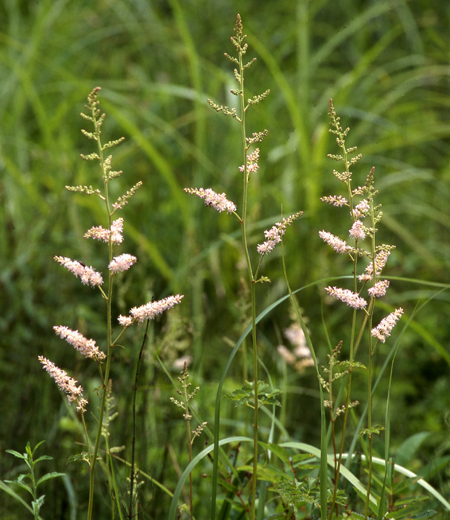 Perennial herbs (grow for several years from their same root system) found in wet grasslands in mountains. In Shinshu area, when picking mushroom called lactarius volemus, stick them on this plant’s stem and carried back home, hence the Japanese name Chidake-sasi literally meaning stick for lactarius volemus. Flowers are 4 mm in diameter with five petals. Bloom many light pink small flowers on 10 to 20 cm thin flower stems. Flower spikes are upright and bloom from the bottom ones. Have short hair on flower stem and brown long hair on stems and leaf stems. Leaves are compound leaf in odd numbers as one set, grow like feather of birds and divided into two to four. The shape of leaves is egg-shaped and 1 to 4 cm long with toothed margins (edges of leaves are like a teeth of saw) and have hair randomly grow on both sides. Bear fruits with two segment when ripen.
Perennial herbs (grow for several years from their same root system) found in wet grasslands in mountains. In Shinshu area, when picking mushroom called lactarius volemus, stick them on this plant’s stem and carried back home, hence the Japanese name Chidake-sasi literally meaning stick for lactarius volemus. Flowers are 4 mm in diameter with five petals. Bloom many light pink small flowers on 10 to 20 cm thin flower stems. Flower spikes are upright and bloom from the bottom ones. Have short hair on flower stem and brown long hair on stems and leaf stems. Leaves are compound leaf in odd numbers as one set, grow like feather of birds and divided into two to four. The shape of leaves is egg-shaped and 1 to 4 cm long with toothed margins (edges of leaves are like a teeth of saw) and have hair randomly grow on both sides. Bear fruits with two segment when ripen.
●Season July to about August
●Height about 30 to 80 cm
●Place Ura-Takao, Oku-Takao -
Macleaya cordata (Plume Poppy) Papaveraceae
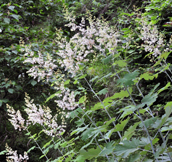
 Macleaya cordata (Plume Poppy) Papaveraceae
Macleaya cordata (Plume Poppy) Papaveraceae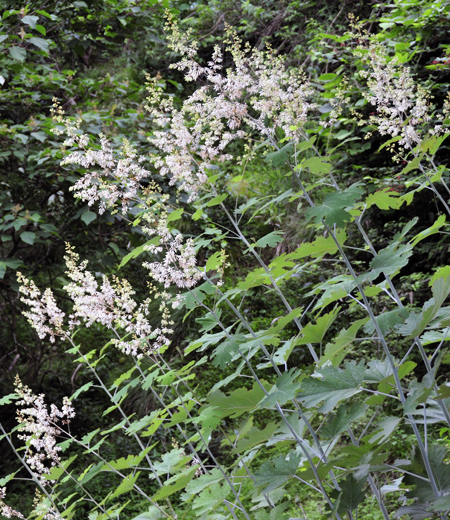 Perennial large herbs found in sunny waste ground and on riverbank. It grows to about 2 m even with the poor soil in the town and the entire plants looks dusted white. Japanese name Takeni-gusa literally meaning bamboo plants was named because stems are hollow like a bamboo. Stems tip grow branches and bloom many small flowers. No petals but 1 cm long calyx drop after flowering and stamens and pistils remain. Leaves are about 20 to 30 long and wide egg-shaped and lobed like chrysanthemum with curled hair on its back. Bear about 2.5 cm long flattened fruits after flowering. The whole plants are toxic and have yellow milky extracts when cutting leaves or stems. Cause vomiting when eating by mistake.
Perennial large herbs found in sunny waste ground and on riverbank. It grows to about 2 m even with the poor soil in the town and the entire plants looks dusted white. Japanese name Takeni-gusa literally meaning bamboo plants was named because stems are hollow like a bamboo. Stems tip grow branches and bloom many small flowers. No petals but 1 cm long calyx drop after flowering and stamens and pistils remain. Leaves are about 20 to 30 long and wide egg-shaped and lobed like chrysanthemum with curled hair on its back. Bear about 2.5 cm long flattened fruits after flowering. The whole plants are toxic and have yellow milky extracts when cutting leaves or stems. Cause vomiting when eating by mistake.
●Season July to about August
●Height about 1 to 2 m
●Place Trail 1, Trail 5, Mt. Inari, Ura-Takao, Oku-Takao -
Cimicifuga japonica(Japanese Bugbane) Ranunculaceae
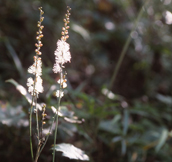
 Cimicifuga japonica(Japanese Bugbane) Ranunculaceae
Cimicifuga japonica(Japanese Bugbane) Ranunculaceae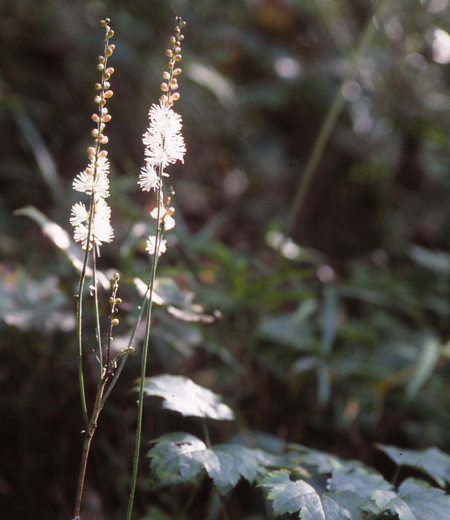 Perennial herbs found in mountainous forests. Grow long flower stalks and bloom with trusses of small white flowers. Petal-like calyx drops after blooming and a stamen and pistils remain. Resemble cimicifuga simplex in the same attribute, but cimicifuga japonica trusses are thinner and have differently shaped leaves. Japanese name Inushouma literally meaning dog shouma plants was named to differentiate itself from similar edible plants cimicifuga simplex (Sarashina-shoma). Cimicifuga japonica is not edible so Inu (dog) was added to its name. Leaves are set of three radical leaves and no leaves grow from stems. Leaves are about 6 to 10 cm long, egg-shaped, three to five lobed like the palm with irregularly toothed margins. Leathery and have hairs along leave veins on both sides. After flowering, bear fruits when ripe.
Perennial herbs found in mountainous forests. Grow long flower stalks and bloom with trusses of small white flowers. Petal-like calyx drops after blooming and a stamen and pistils remain. Resemble cimicifuga simplex in the same attribute, but cimicifuga japonica trusses are thinner and have differently shaped leaves. Japanese name Inushouma literally meaning dog shouma plants was named to differentiate itself from similar edible plants cimicifuga simplex (Sarashina-shoma). Cimicifuga japonica is not edible so Inu (dog) was added to its name. Leaves are set of three radical leaves and no leaves grow from stems. Leaves are about 6 to 10 cm long, egg-shaped, three to five lobed like the palm with irregularly toothed margins. Leathery and have hairs along leave veins on both sides. After flowering, bear fruits when ripe.
●Season July to about September
●Height about 60 to 80 cm
●Place Trail 1 to 6, Mt. Inari, Jyataki, Ura-Takao, Oku-Takao
